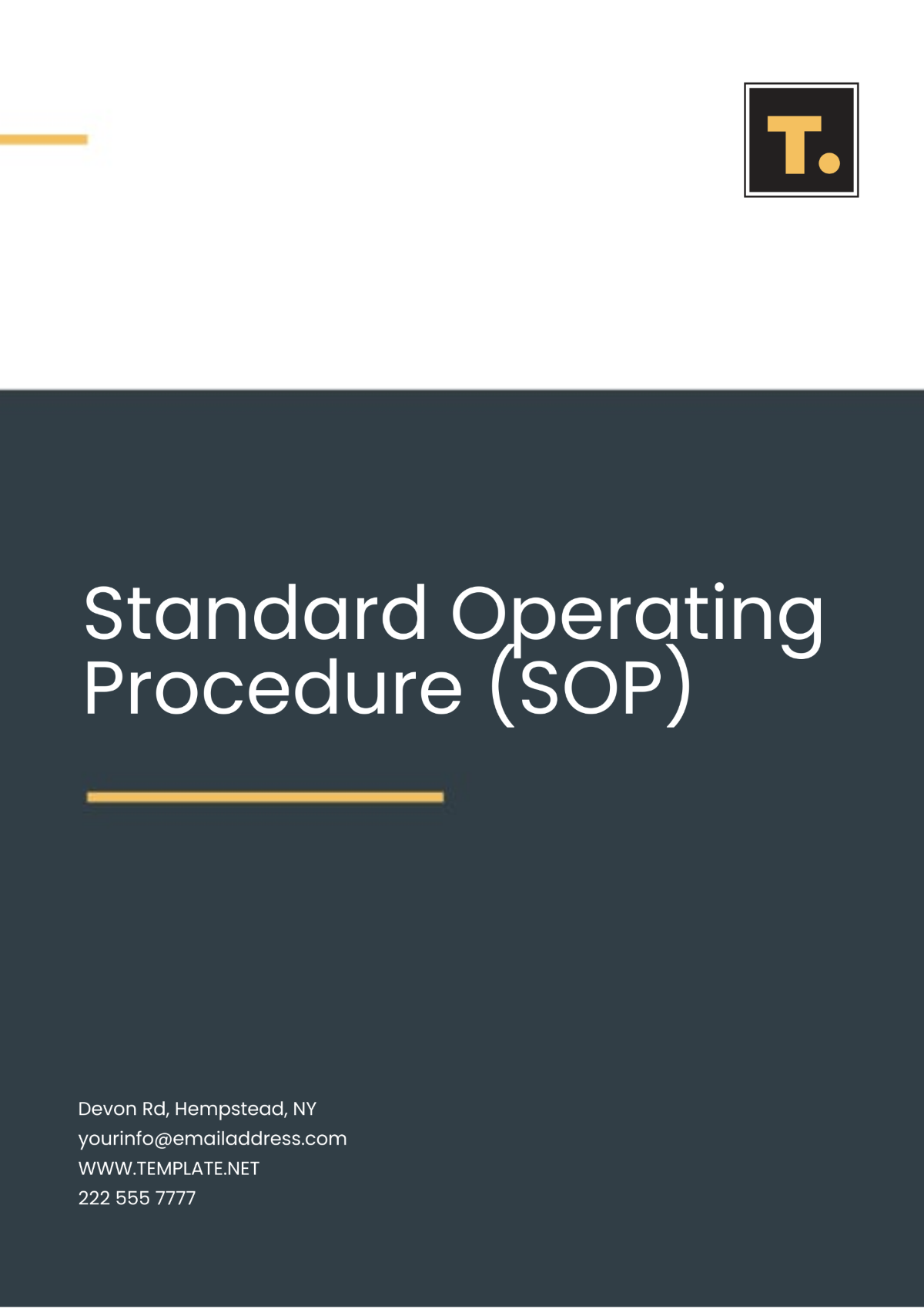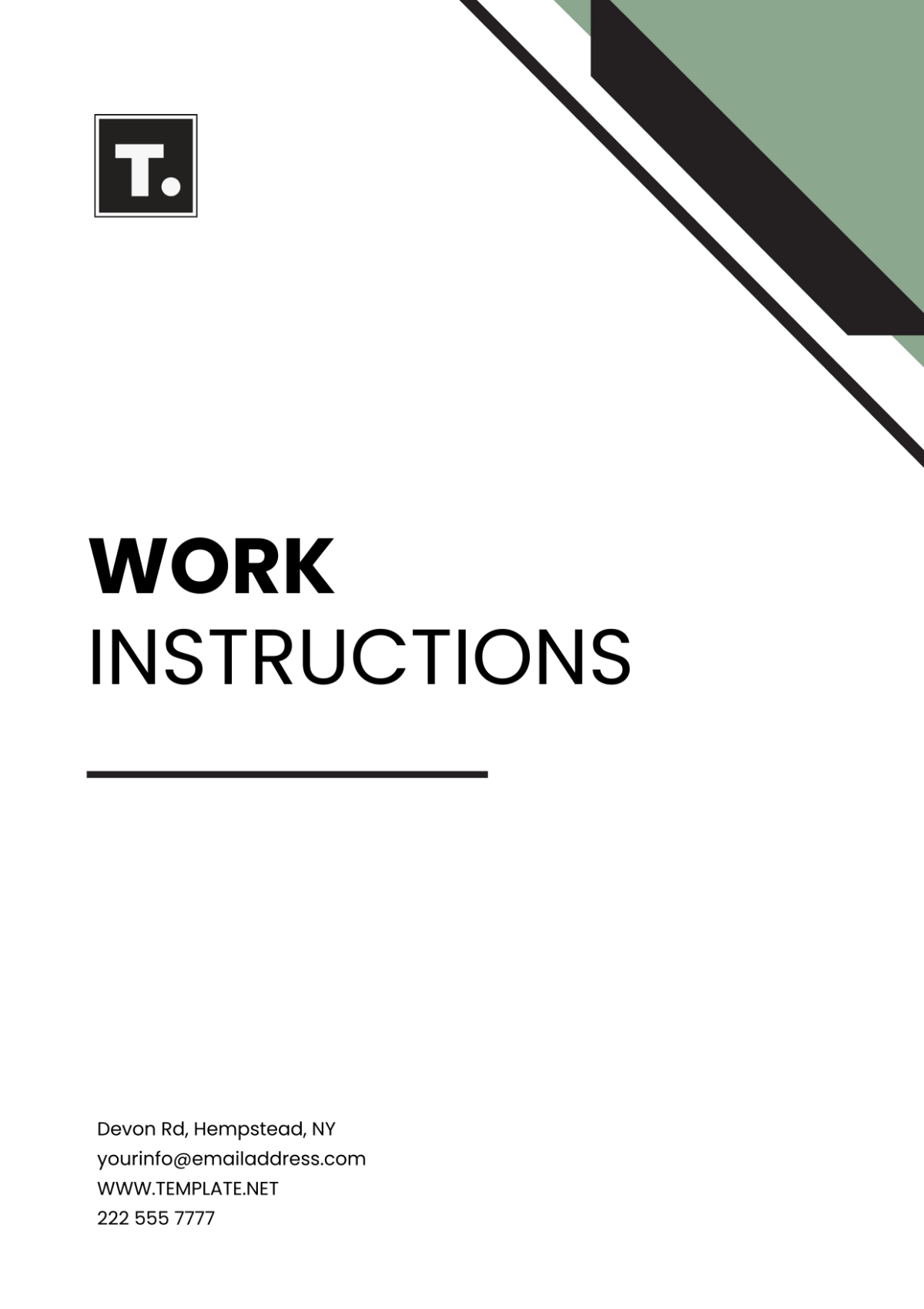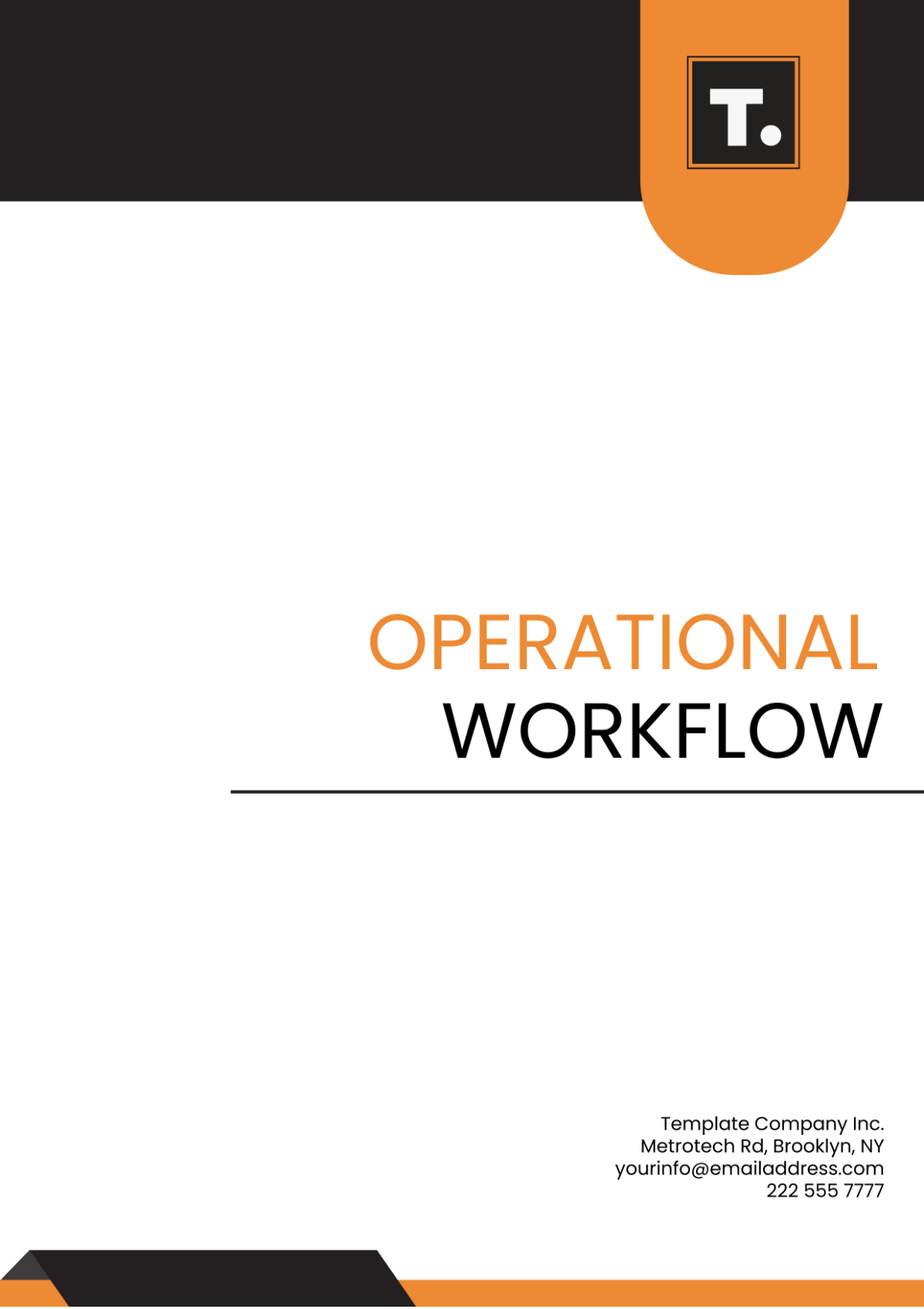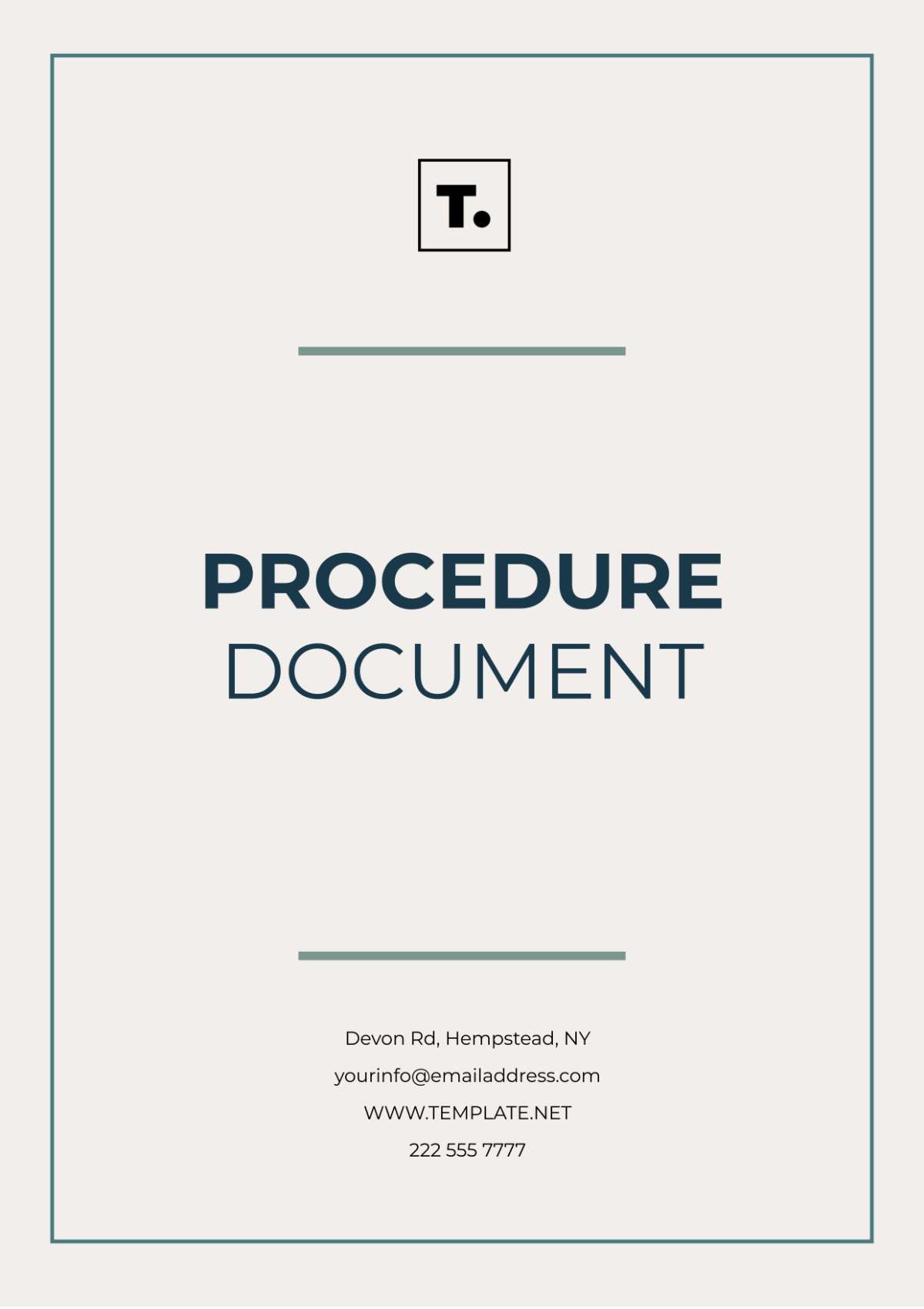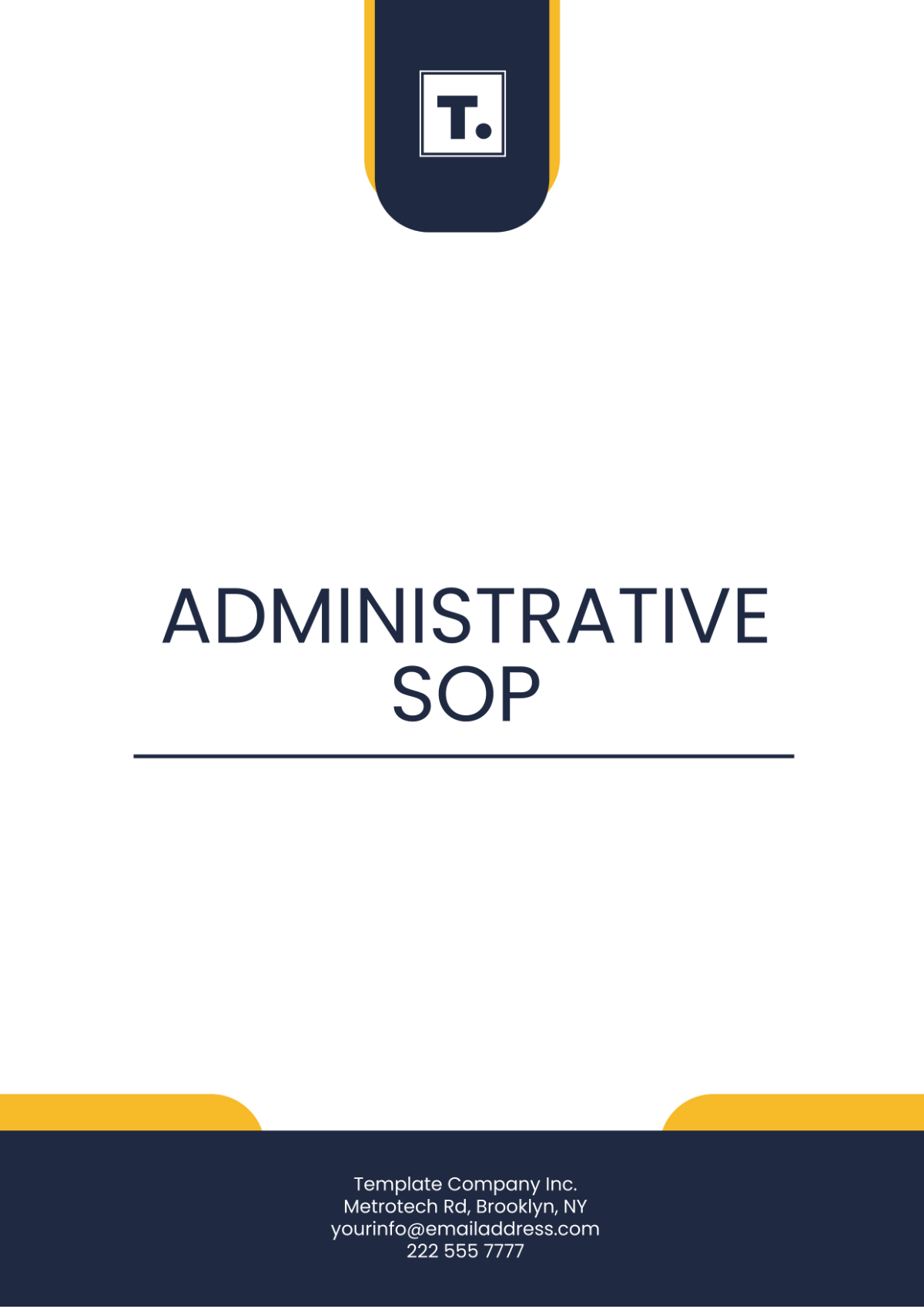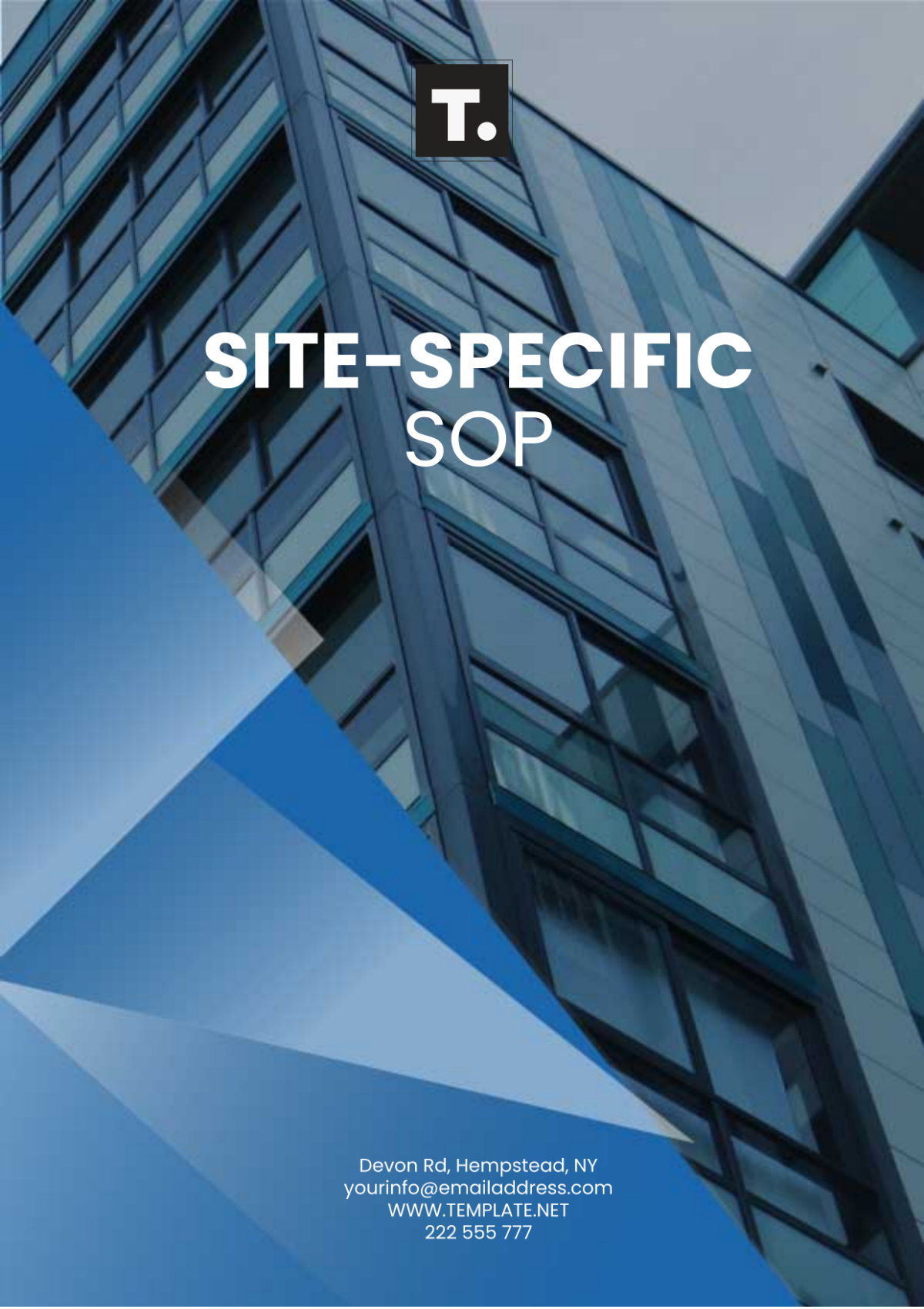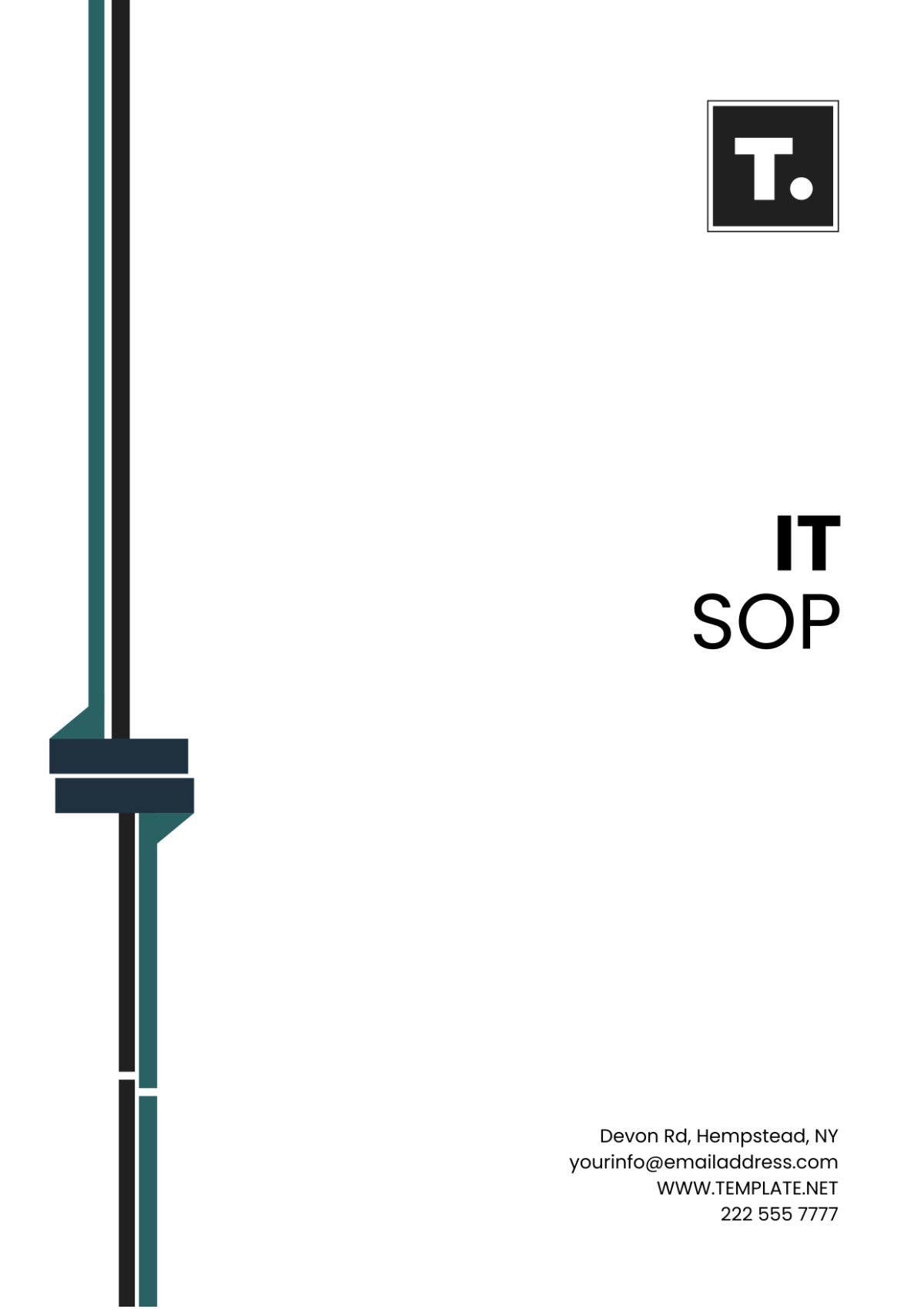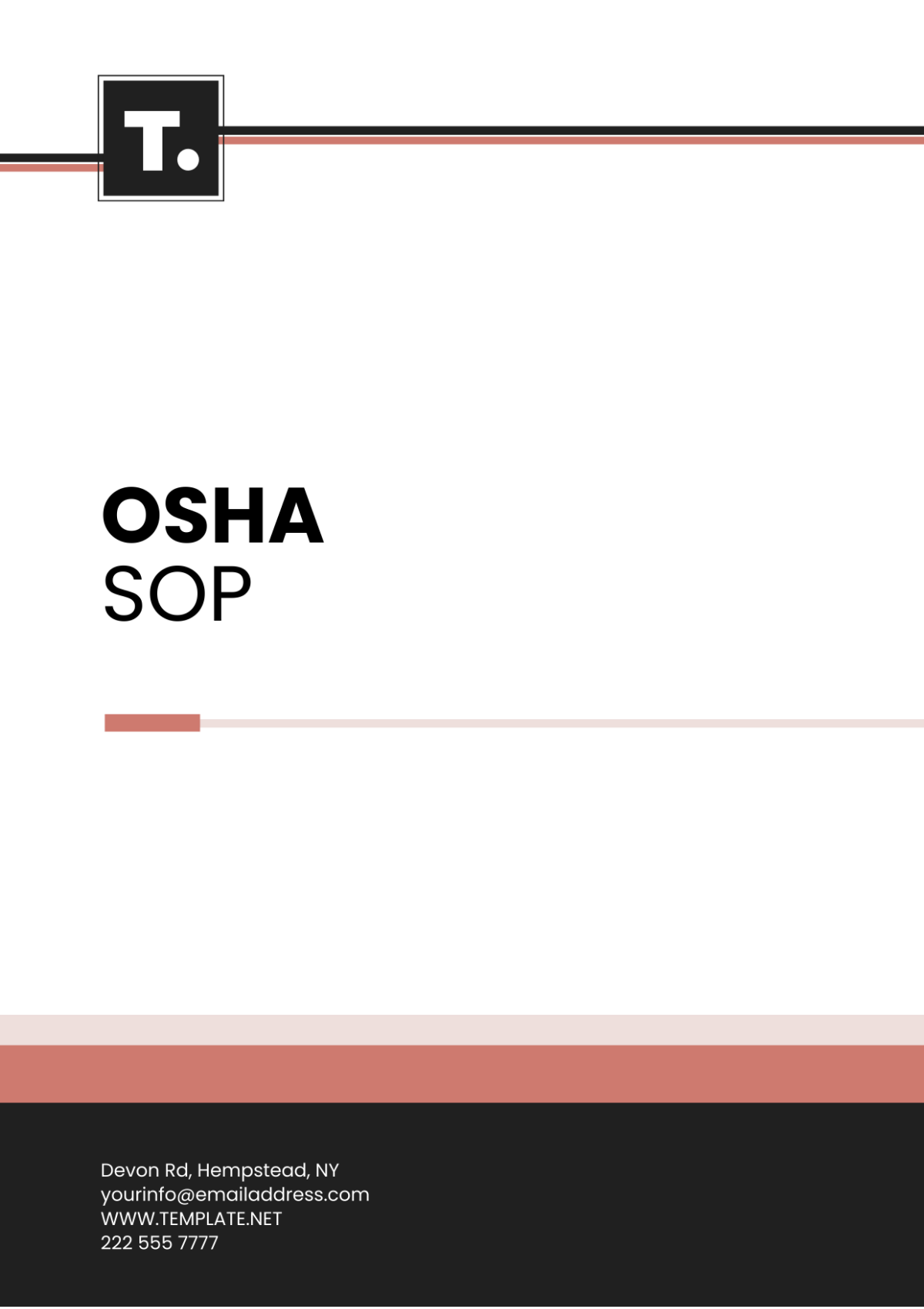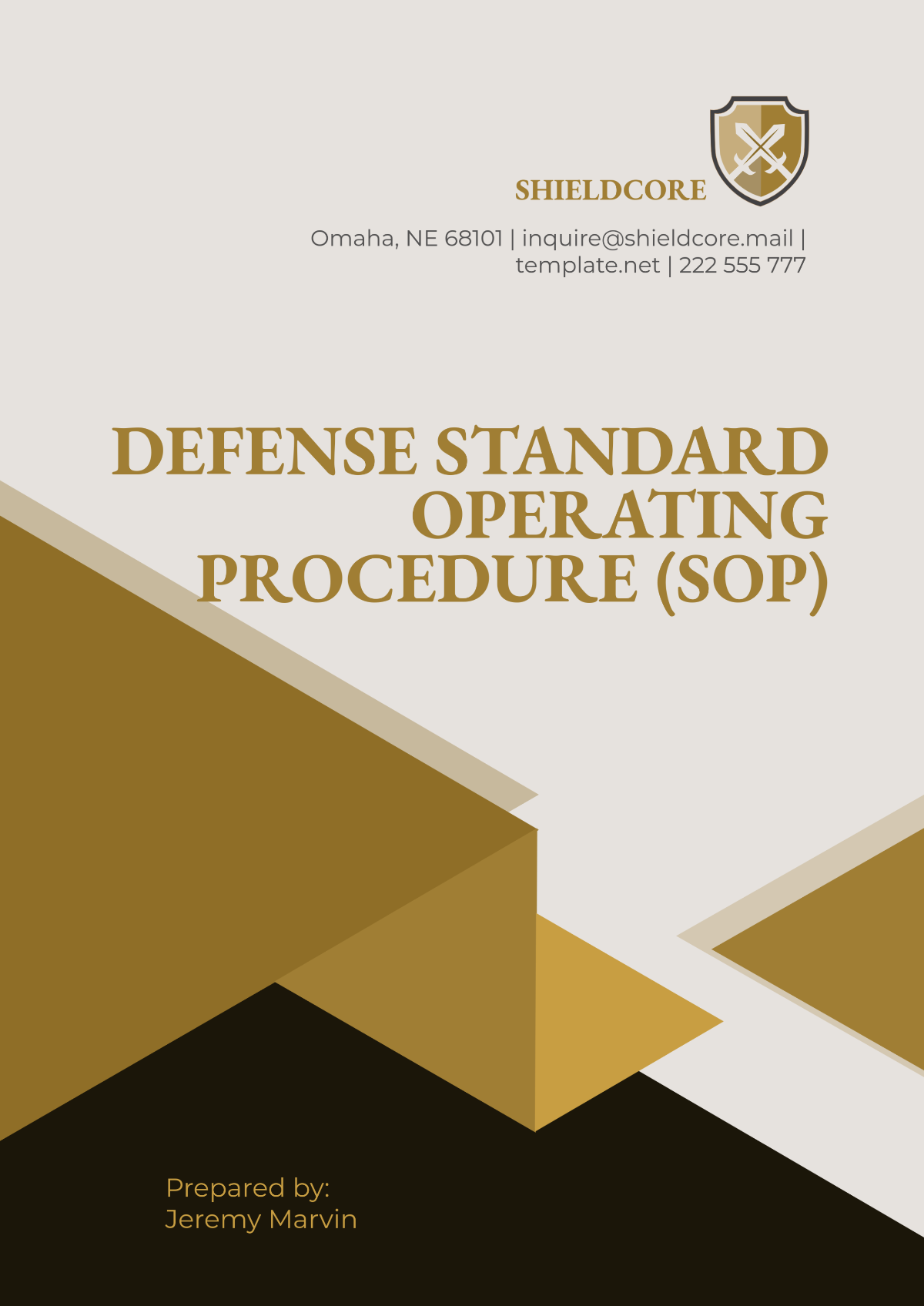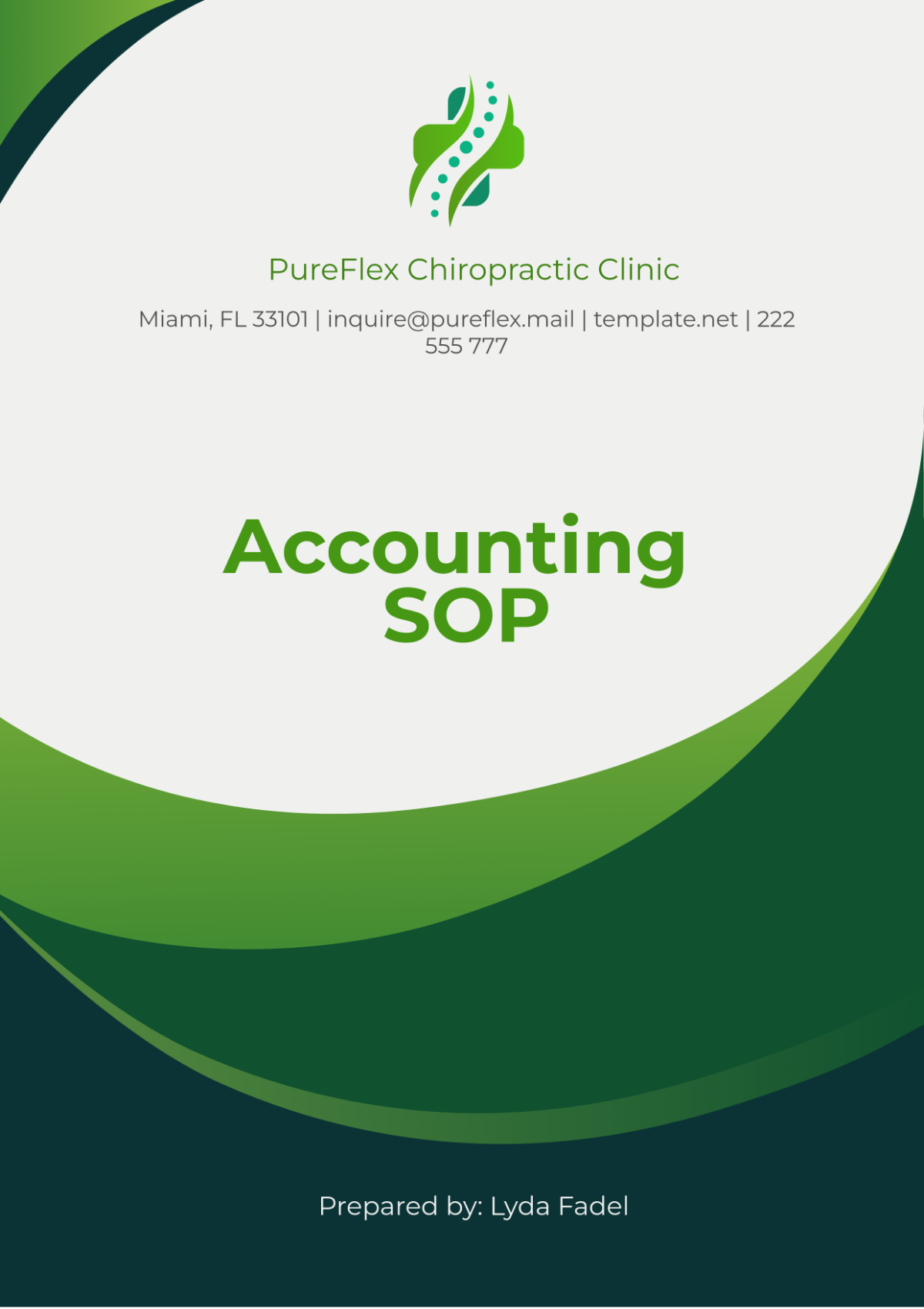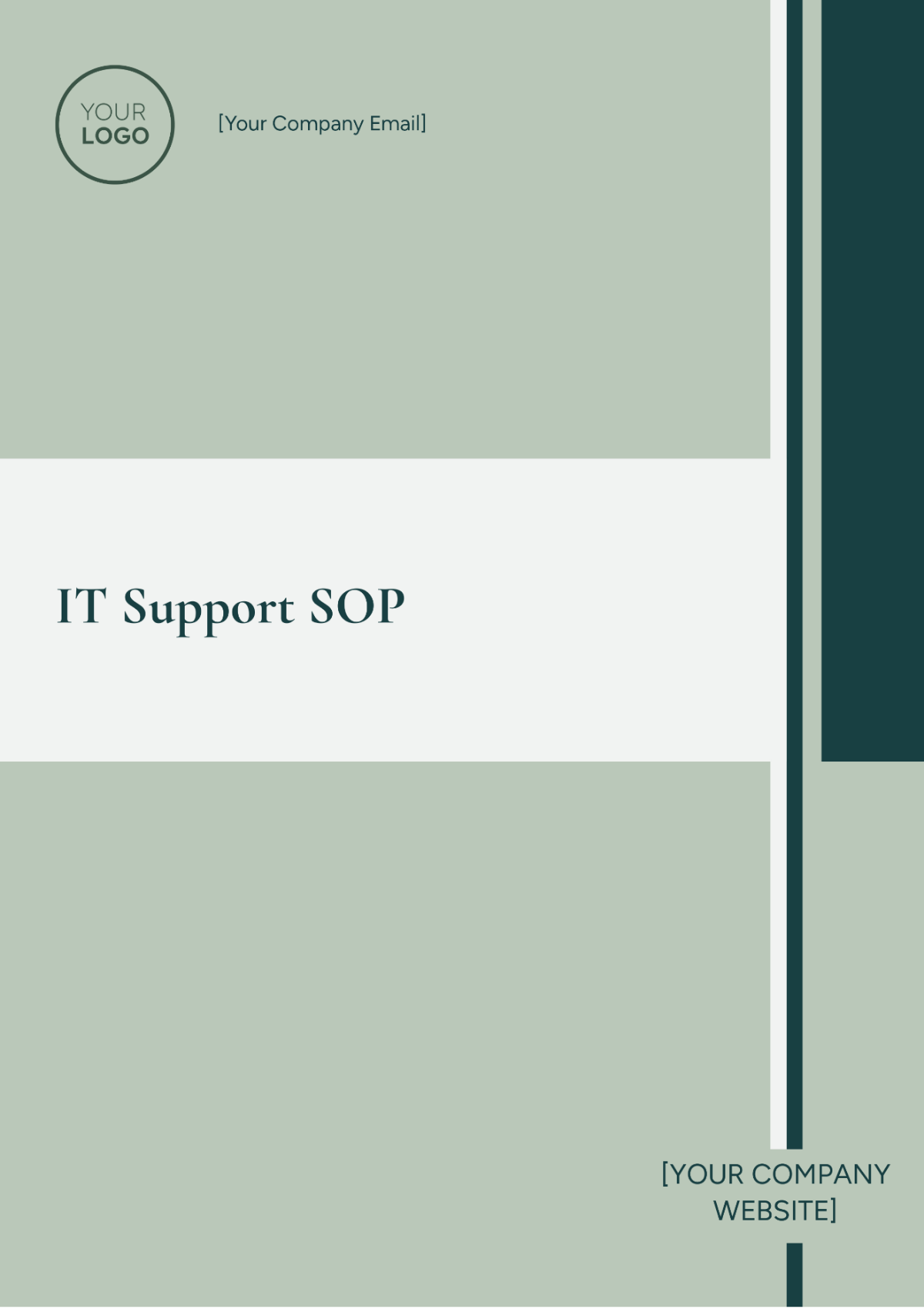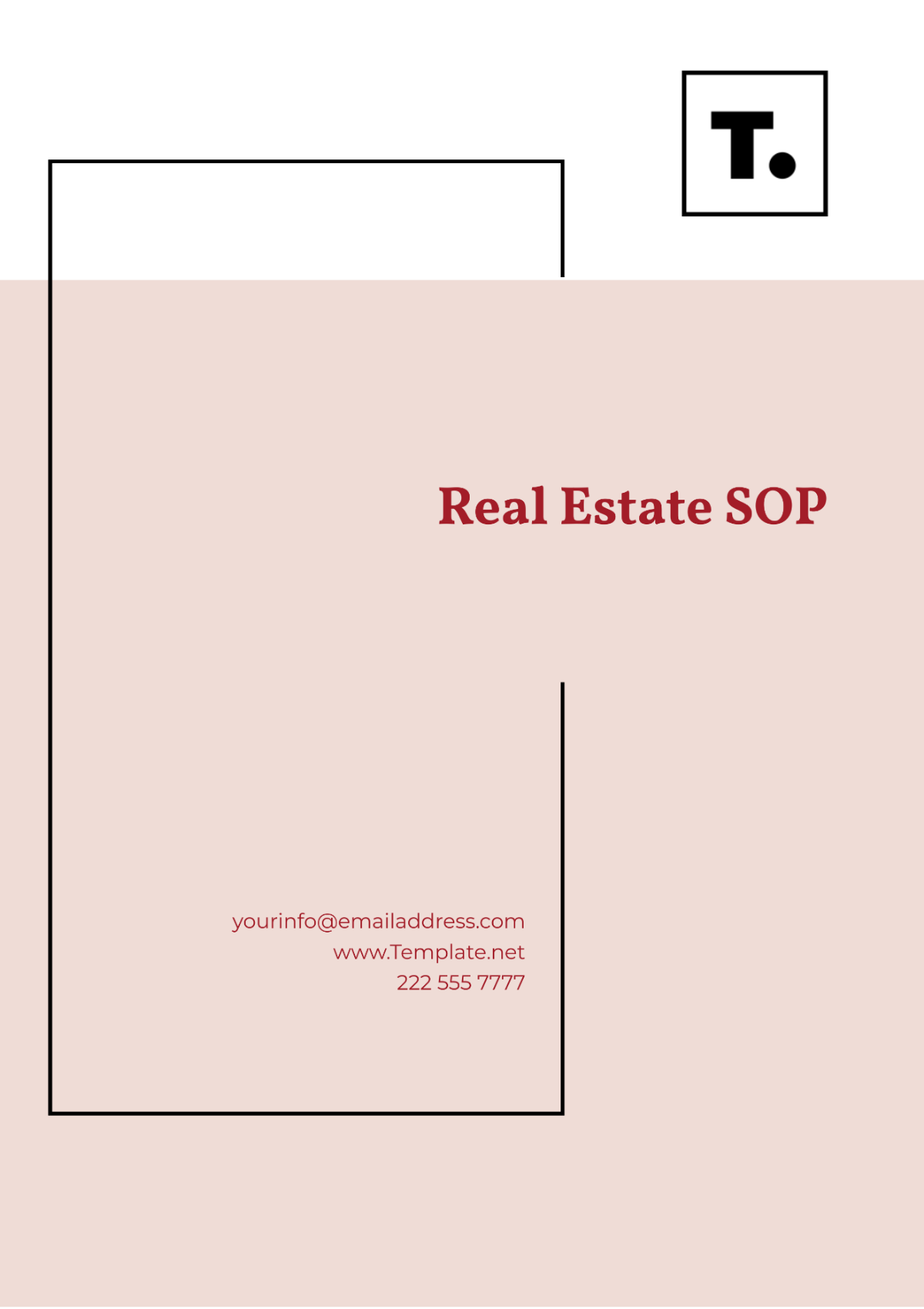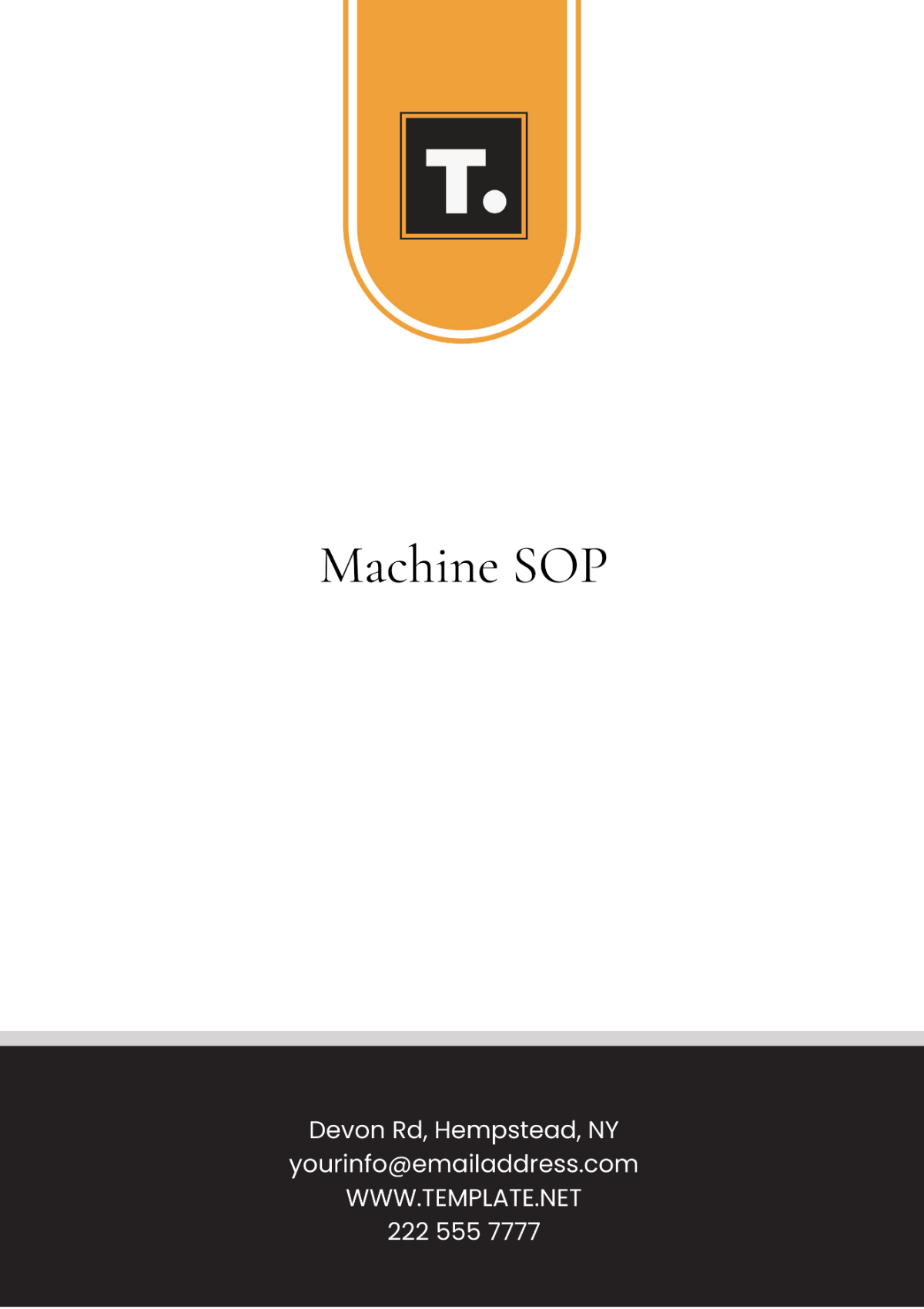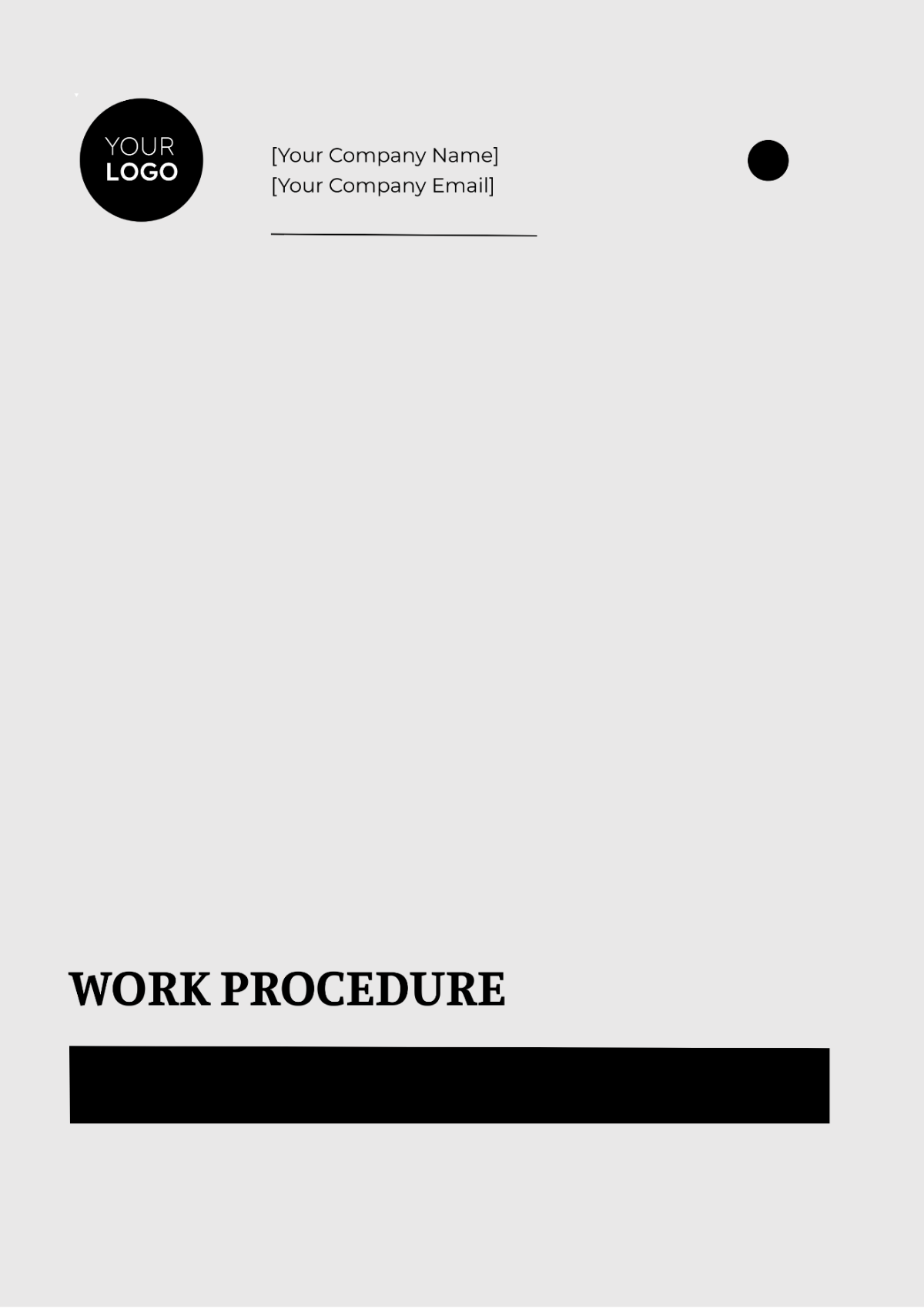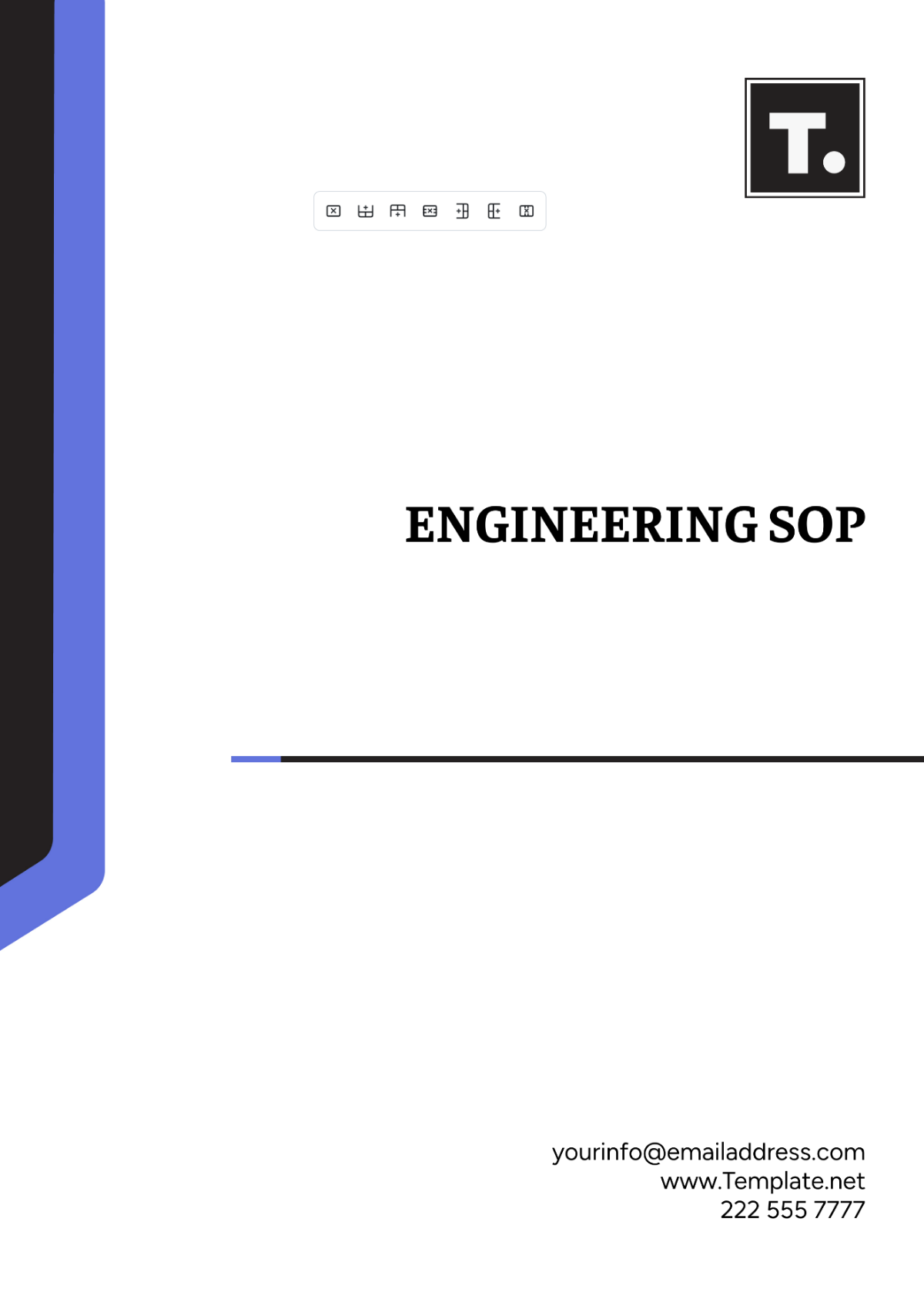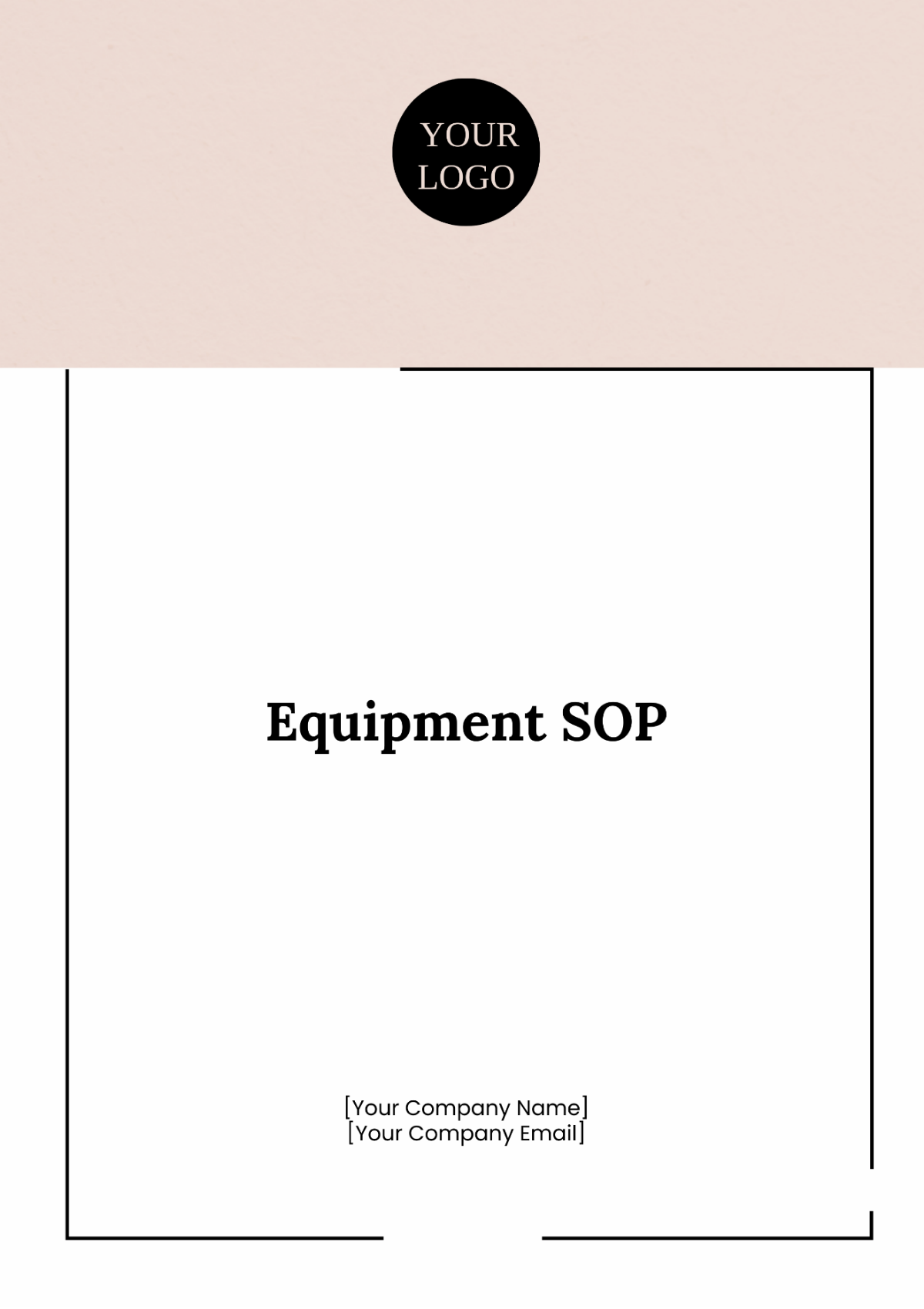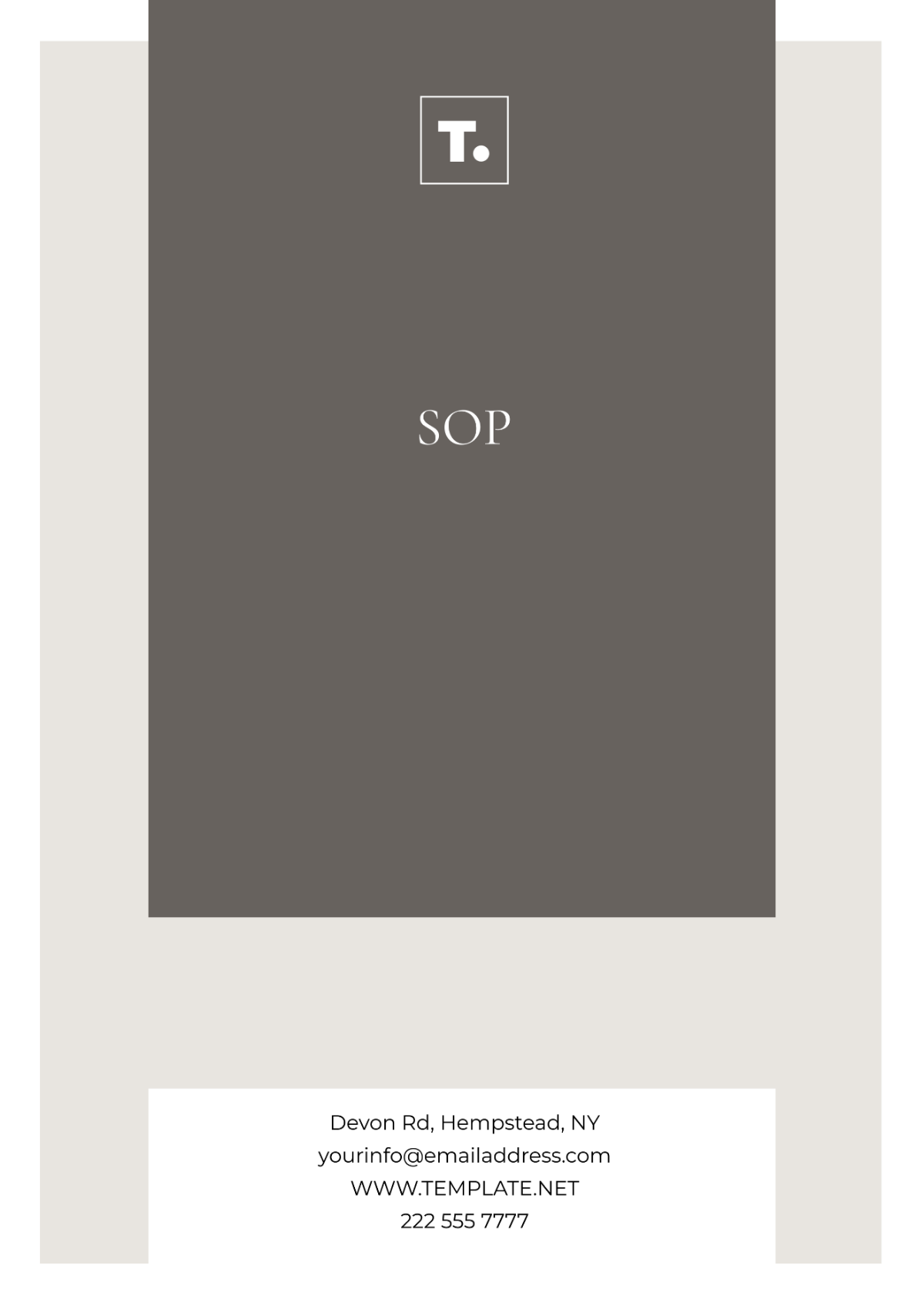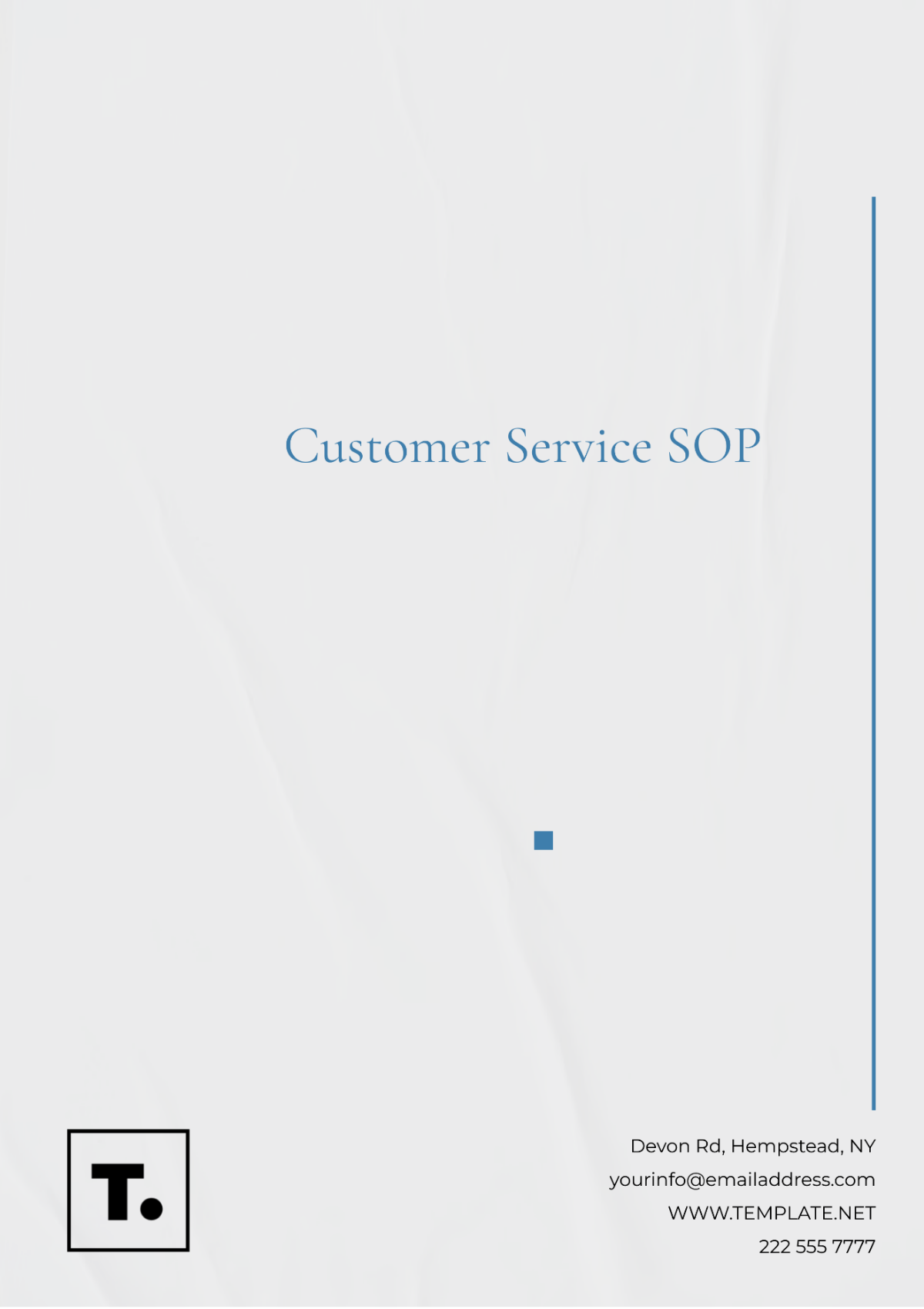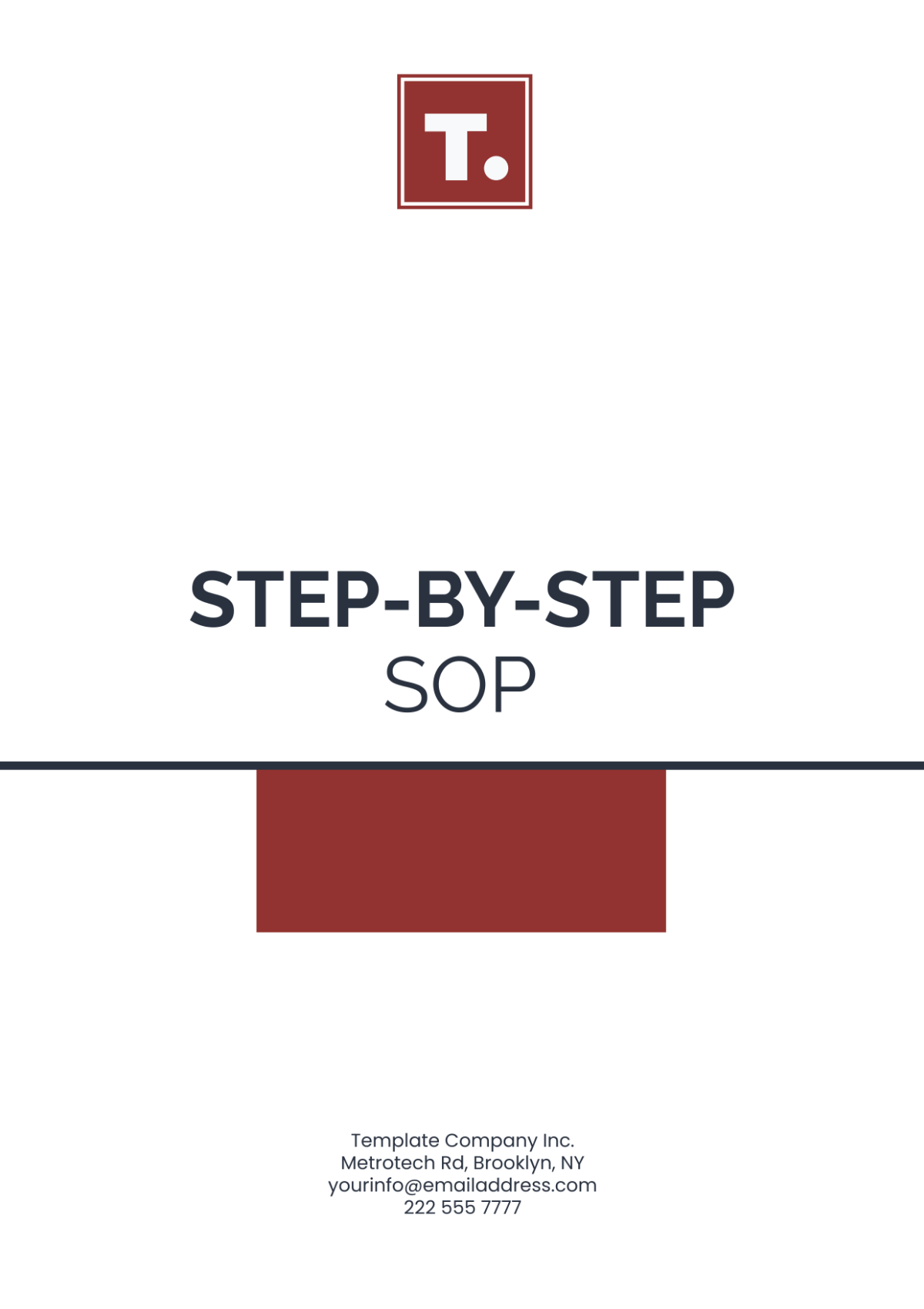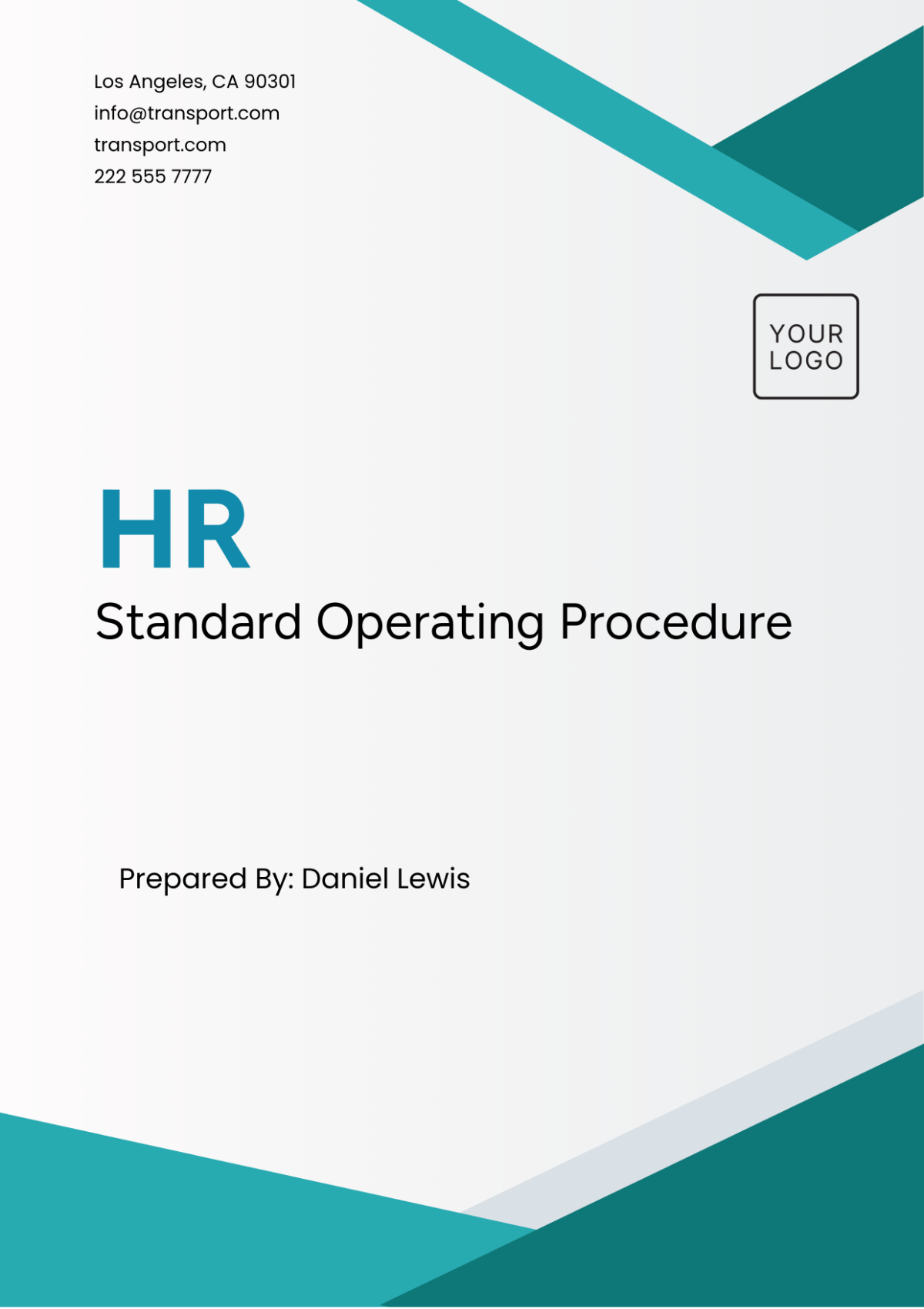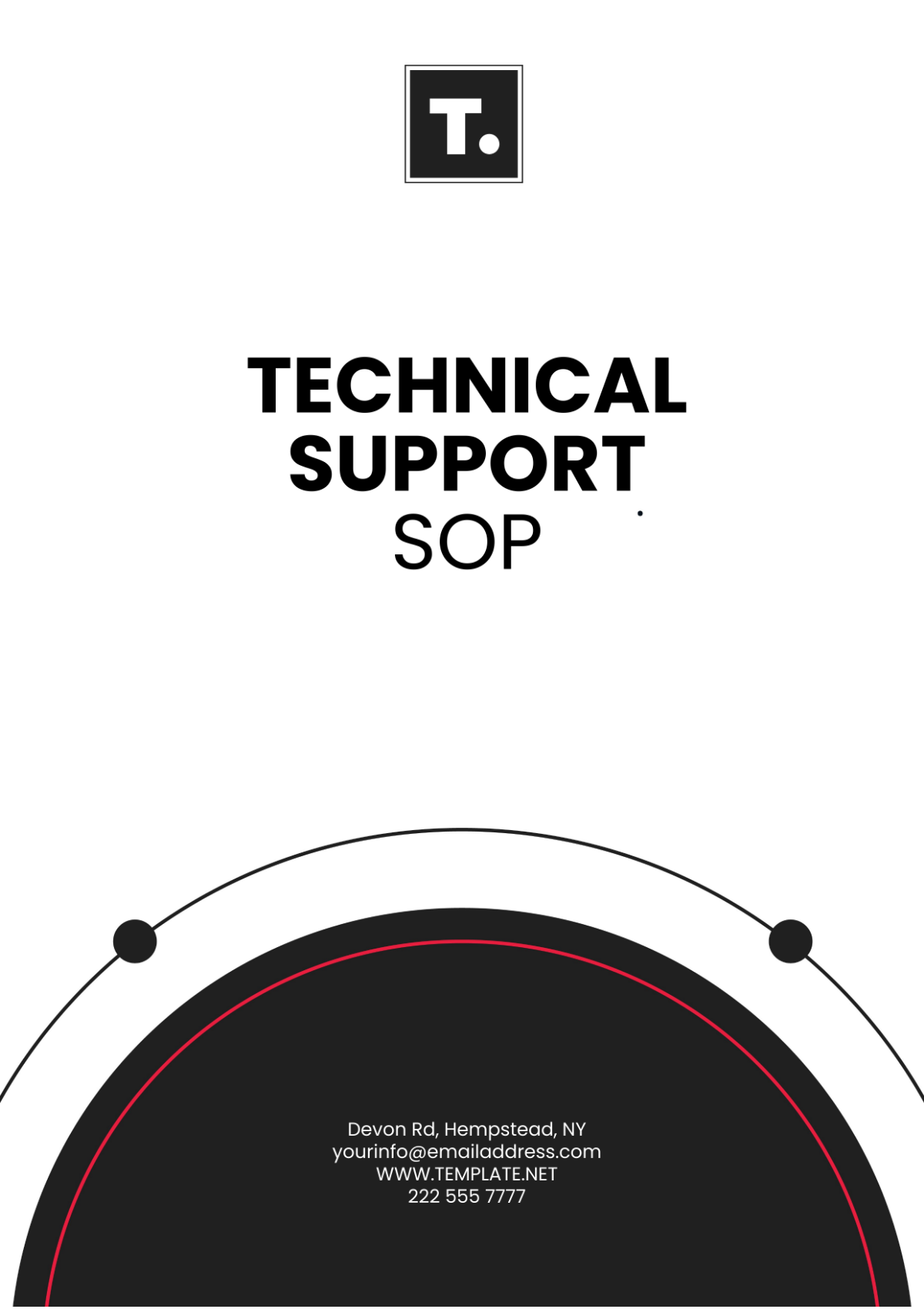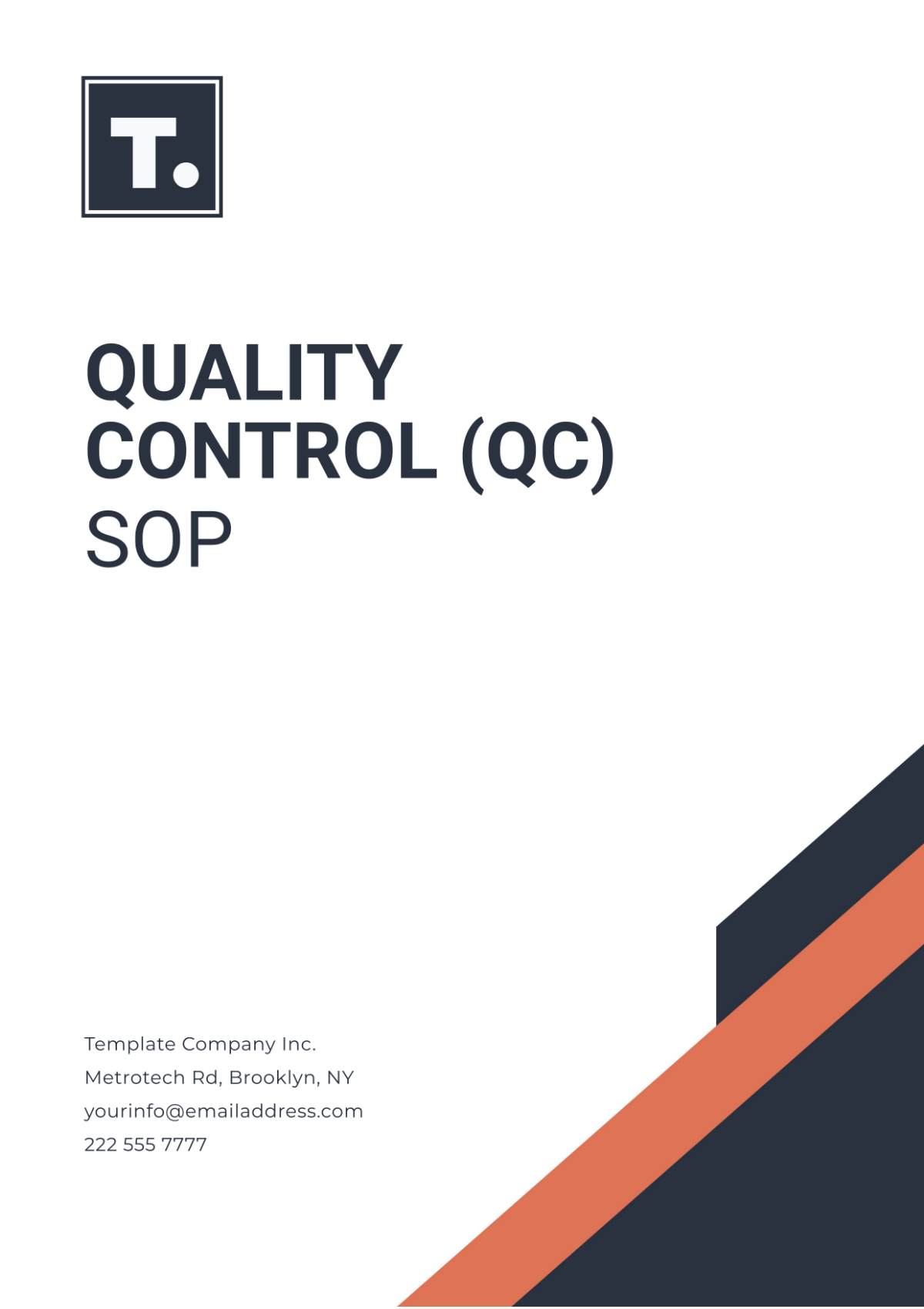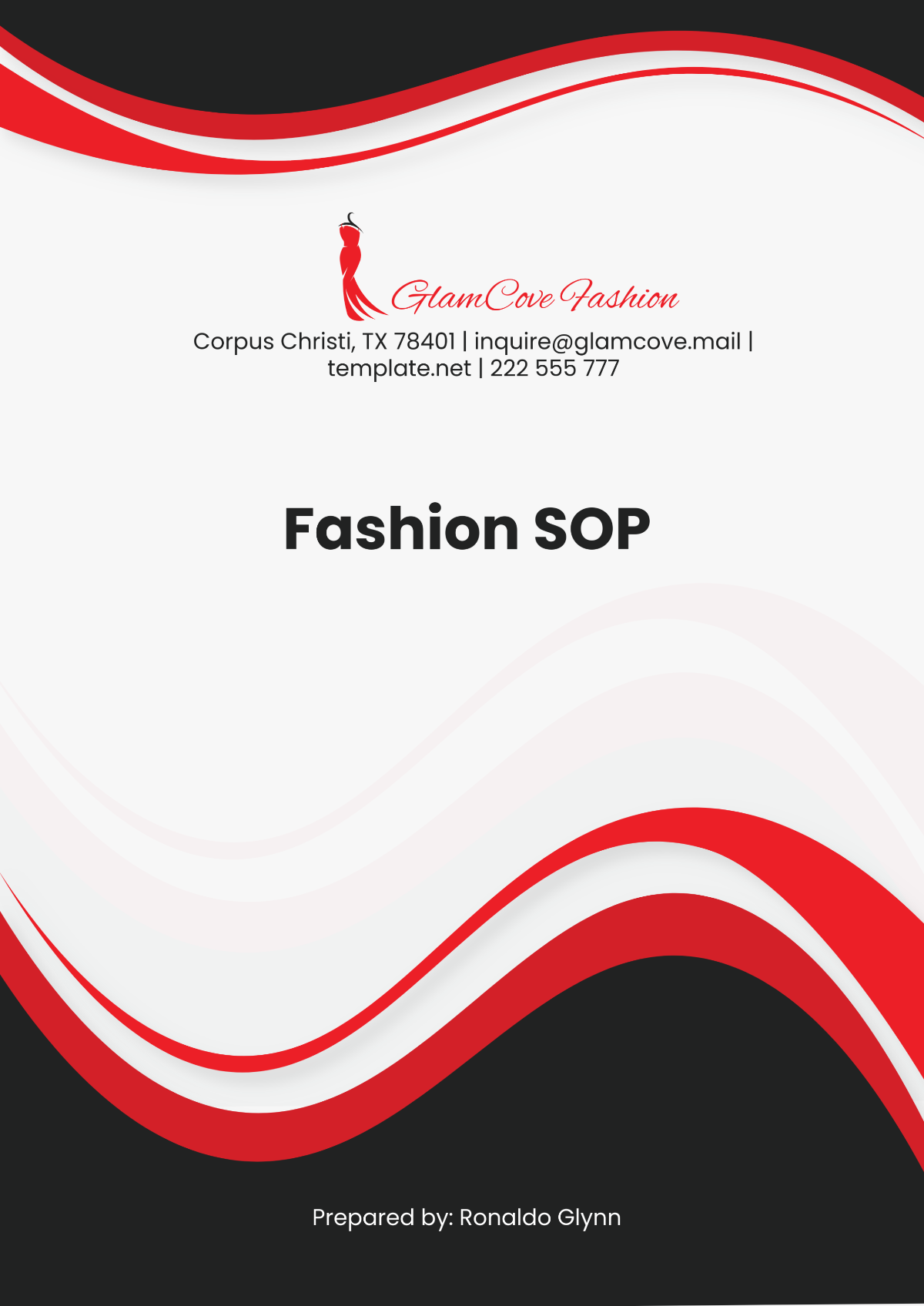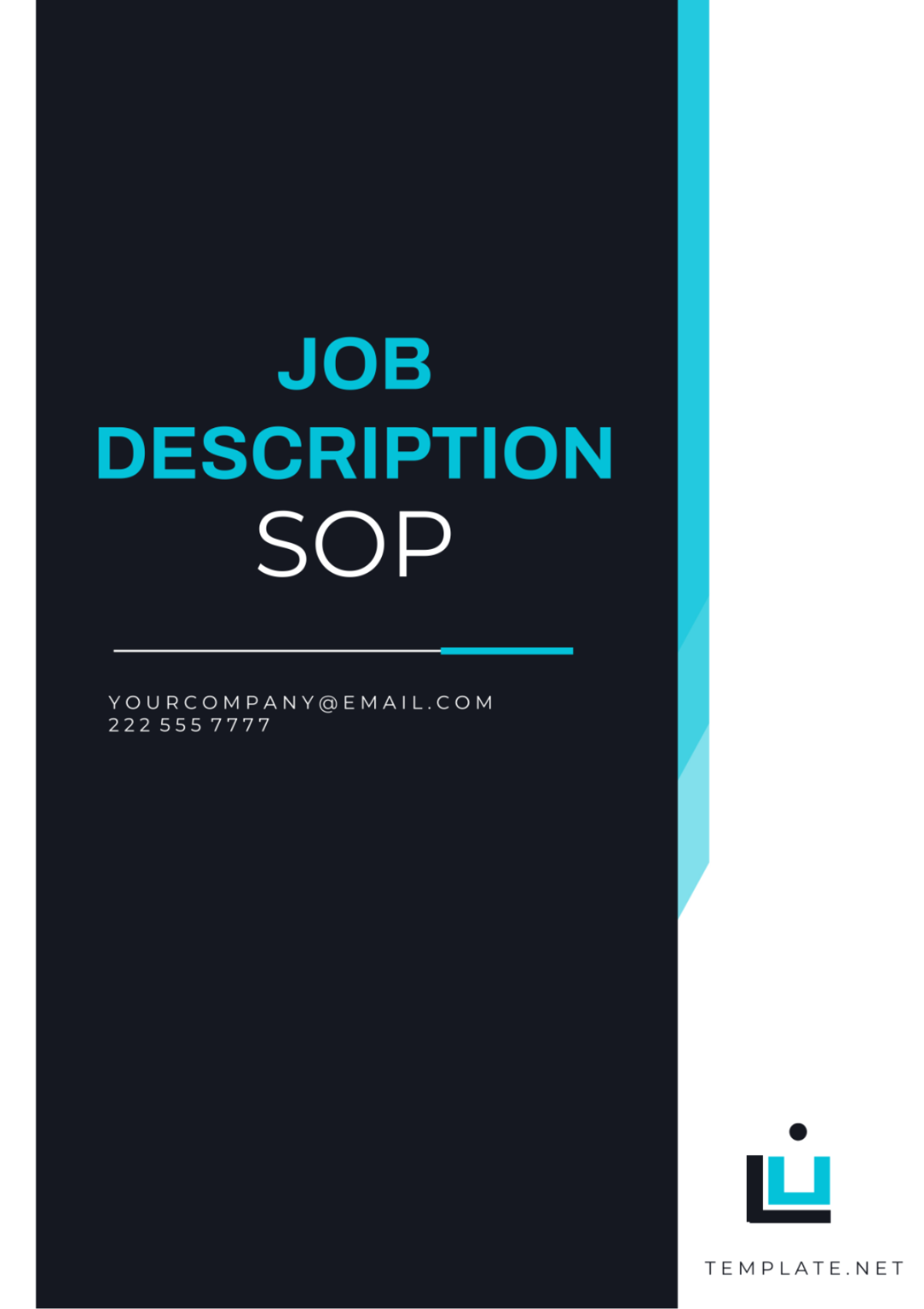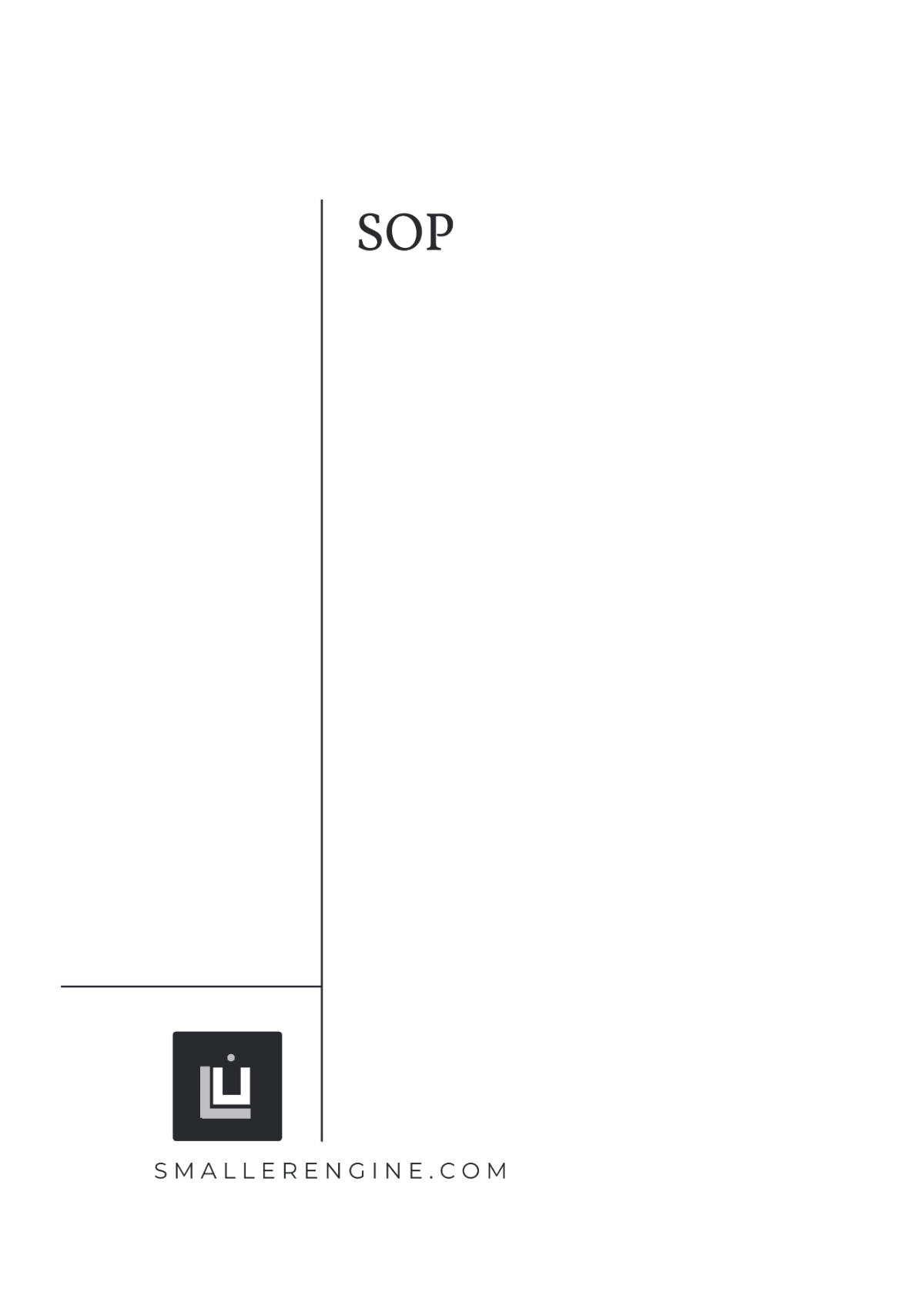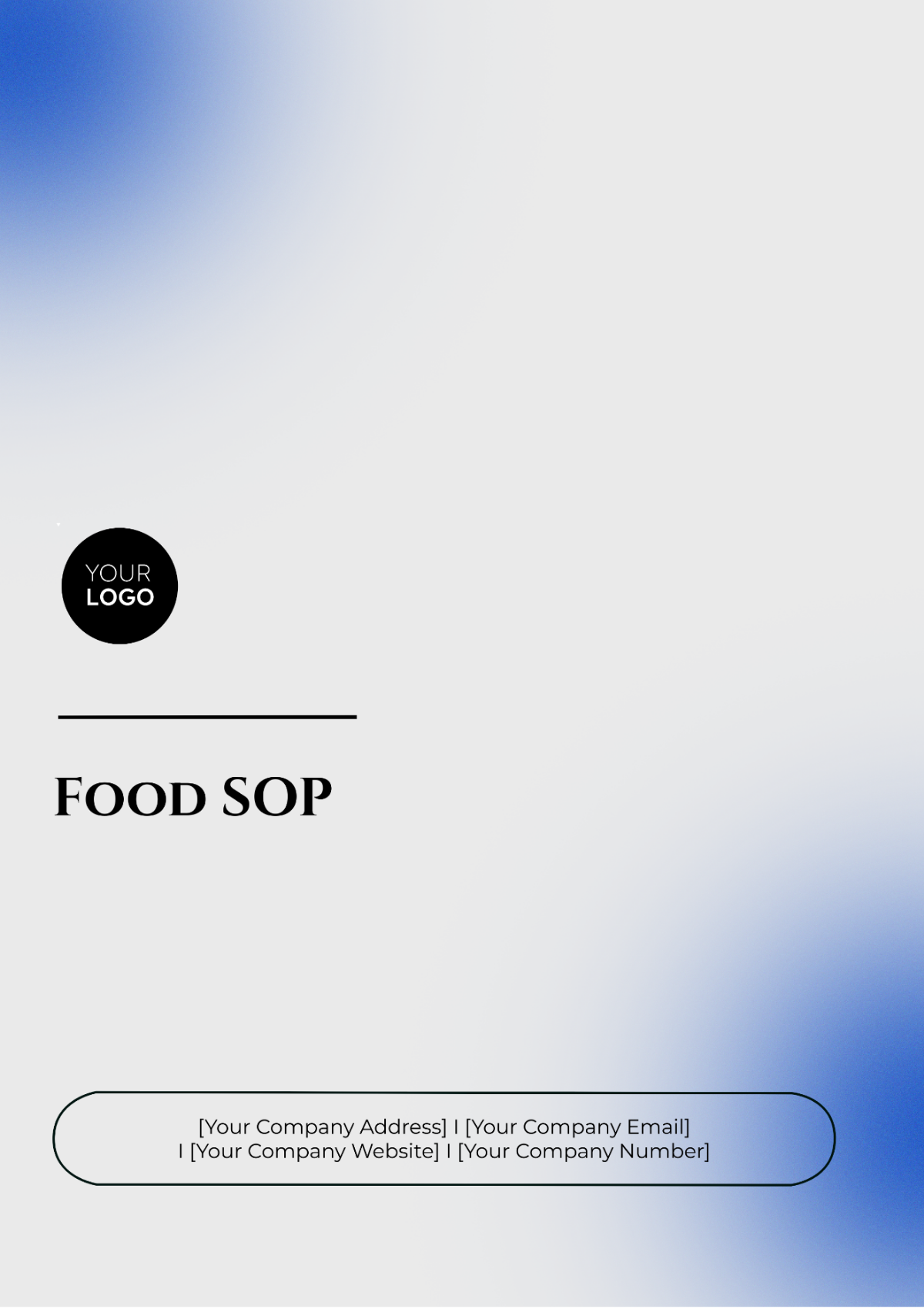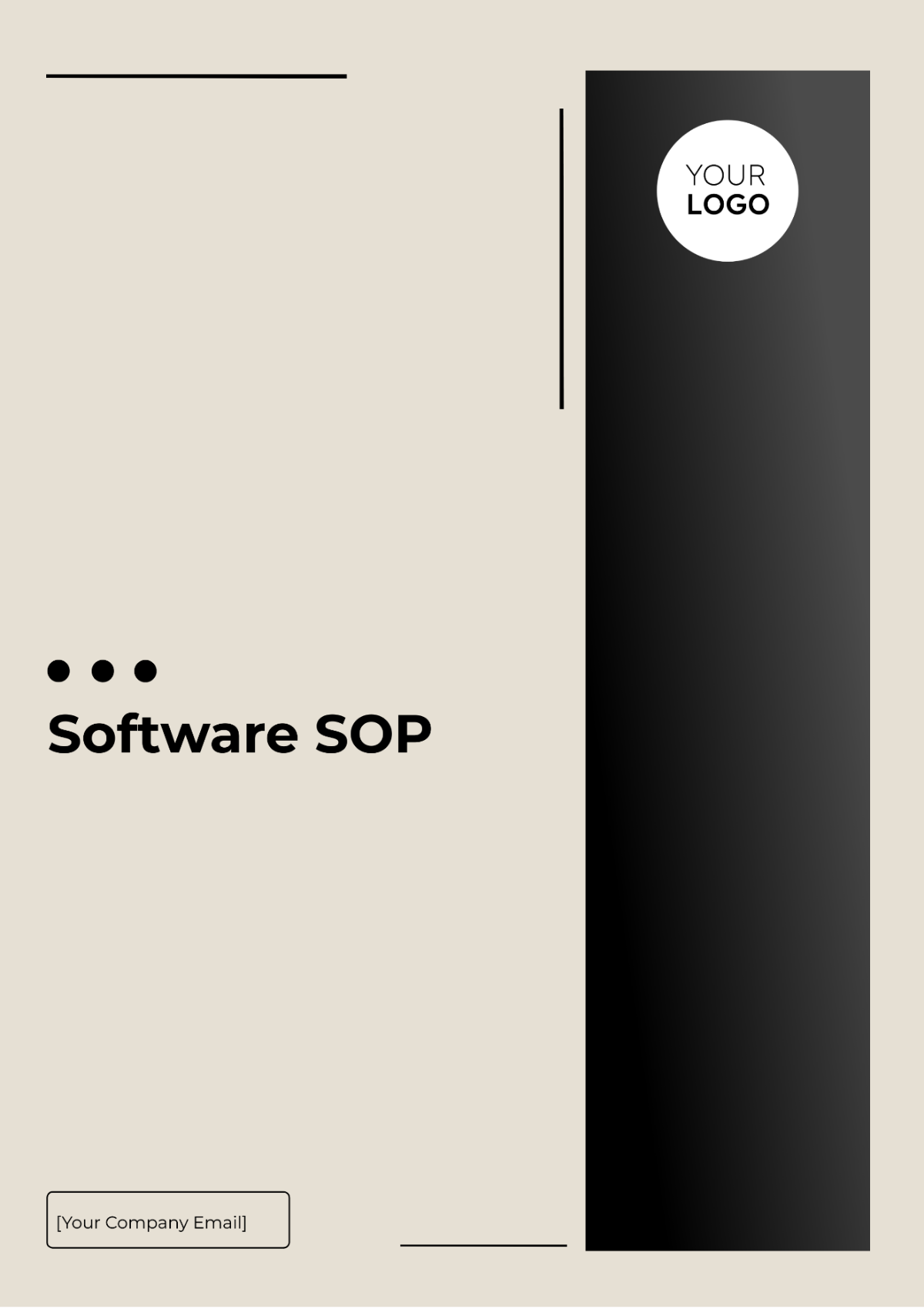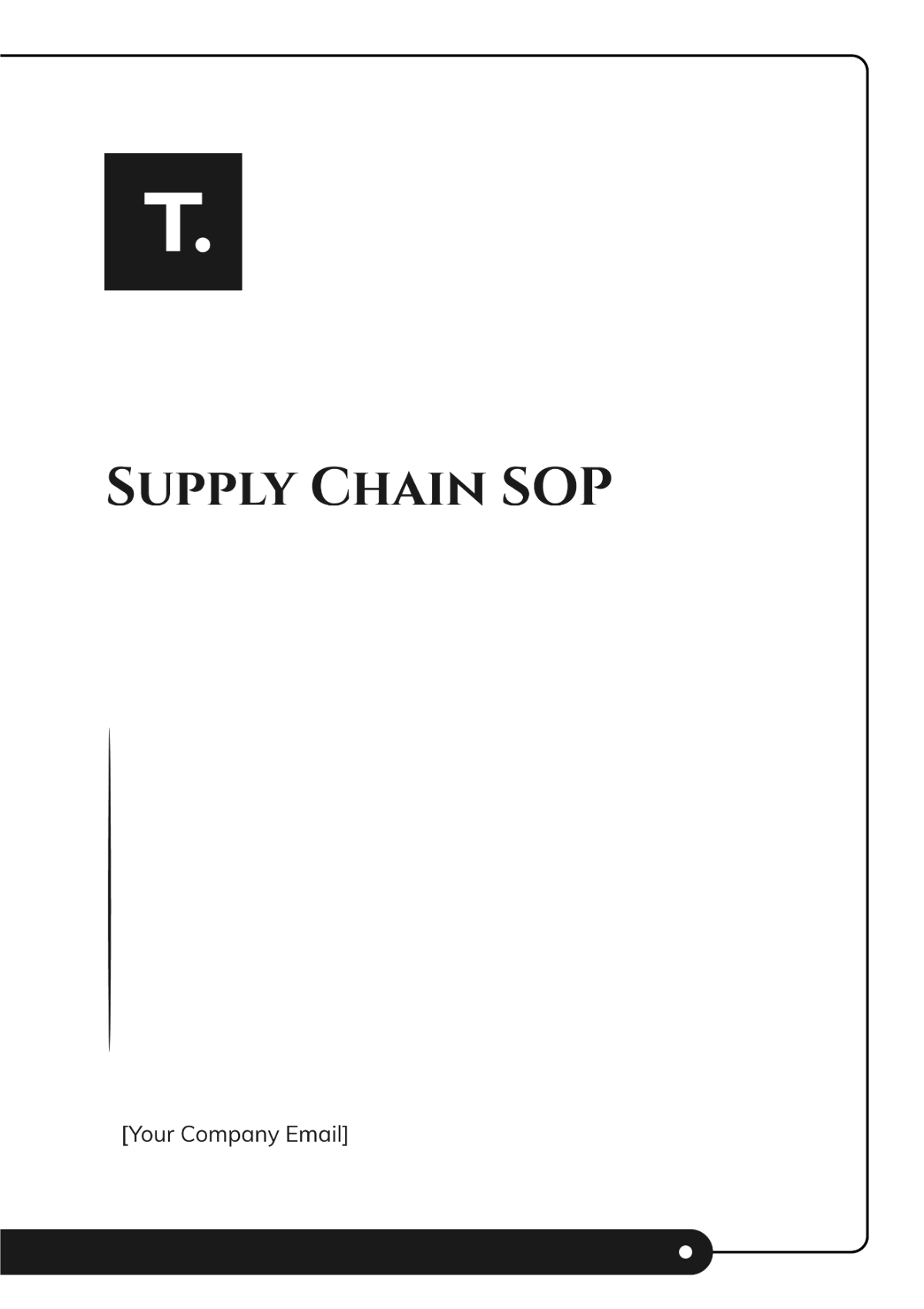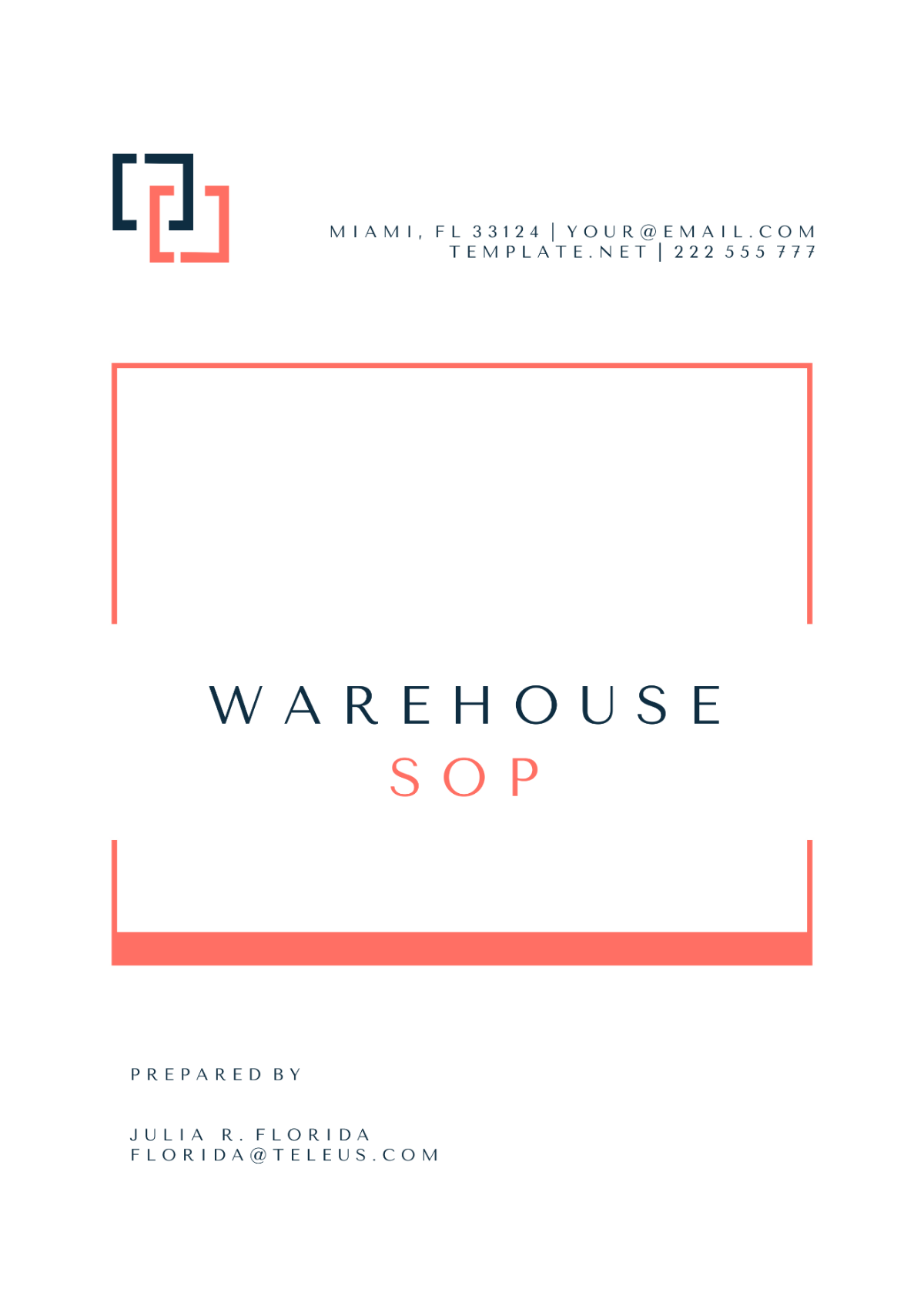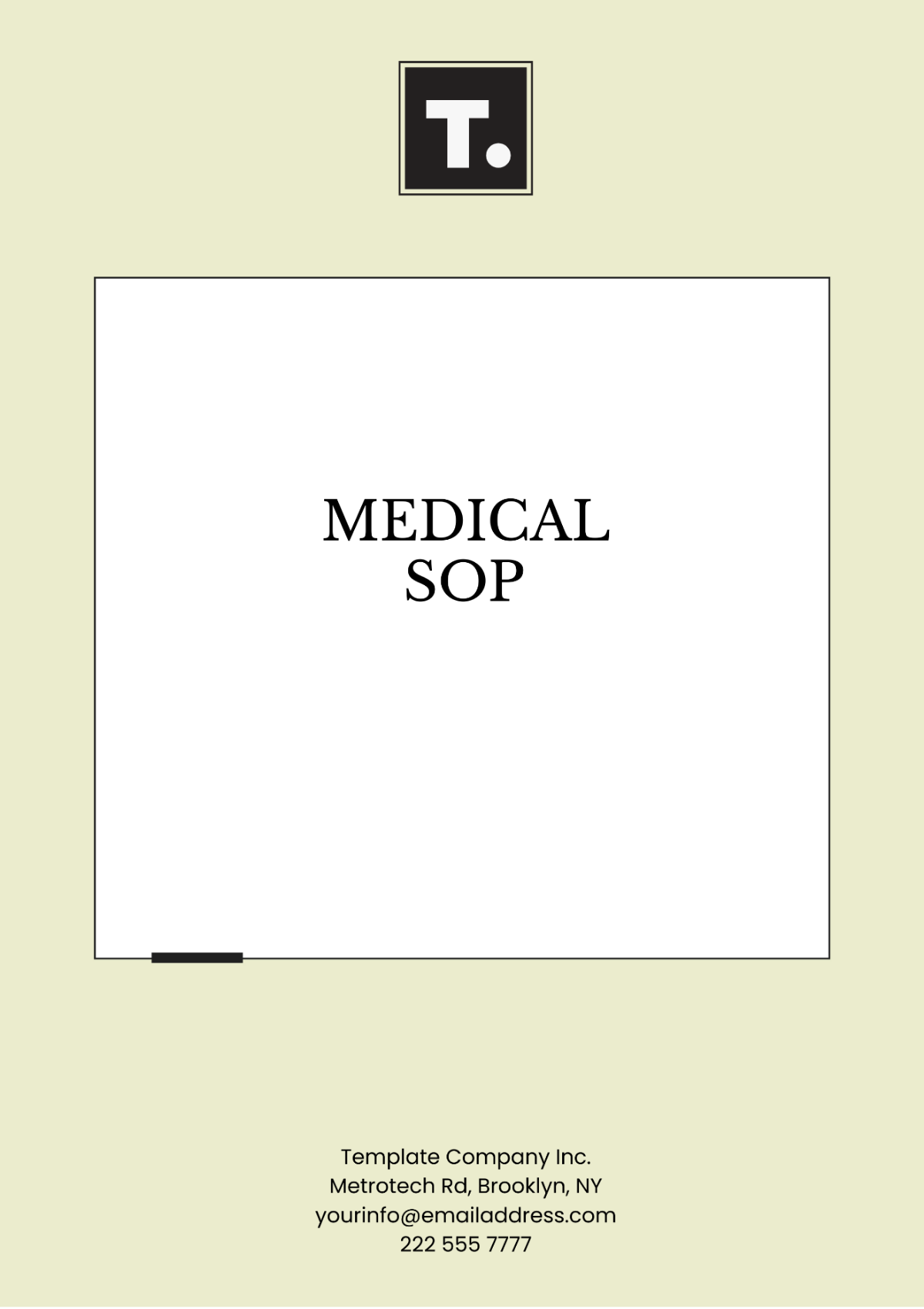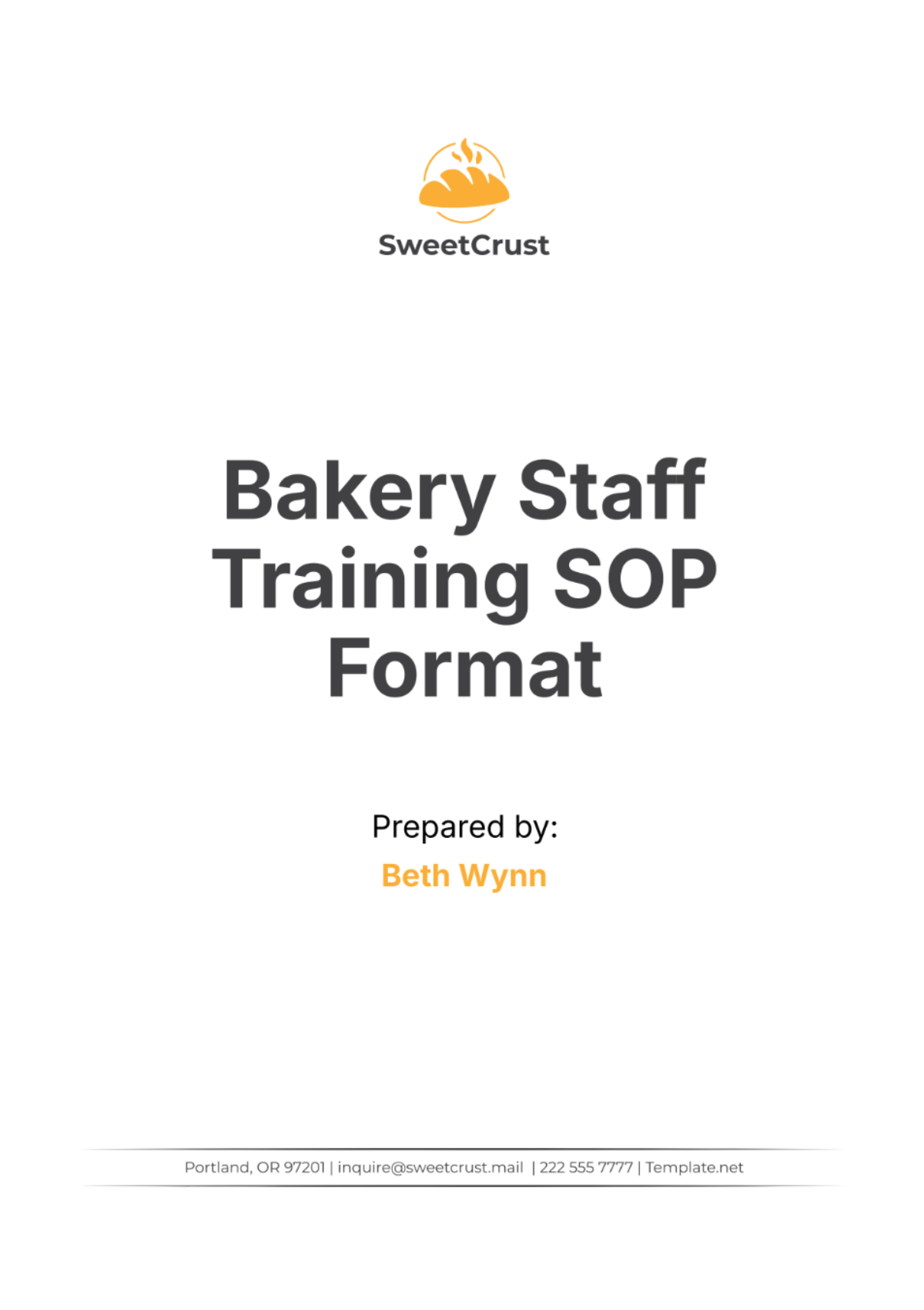Free Bakery Quality Control SOP Template
Bakery Quality Control SOP
I. Introduction
This Bakery Quality Control SOP outlines the quality control processes at [Your Company Name] to ensure consistency, safety, and high standards in our baked goods. Our commitment to quality is vital to maintaining customer satisfaction and upholding our reputation in the bakery industry.
A. Purpose
Consistency: Establish procedures to ensure consistent quality in all baked goods. Consistency is crucial to meet customer expectations and maintain brand reputation.
Safety: Implement safety measures to protect consumers and employees. Safety protocols help prevent contamination and ensure safe food handling.
Standards: Uphold high-quality standards by adhering to established guidelines. Maintaining standards ensures the delivery of superior products to our customers.
B. Scope
Applicability: This SOP applies to all production processes within [Your Company Name]. Applicability ensures that all staff members are aware of and adhere to quality control procedures.
Responsibility: Define the roles and responsibilities of staff involved in quality control. Clear responsibilities ensure accountability and proper execution of procedures.
Continuous Improvement: Encourage continuous improvement of quality control processes. Continuous improvement helps us adapt to changing industry standards and customer needs.
C. Objectives
Customer Satisfaction: Enhance customer satisfaction by delivering high-quality products. Satisfied customers are more likely to return and recommend our bakery to others.
Efficiency: Improve production efficiency through effective quality control. Efficiency reduces waste and increases productivity.
Compliance: Ensure compliance with industry regulations and standards. Compliance protects our business from legal issues and enhances our credibility.
II. Ingredient Quality Control
Ensuring the quality of ingredients is the foundation of producing high-quality baked goods. The following table outlines key aspects of ingredient quality control:
No. | Ingredient Aspect | Control Measure |
|---|---|---|
1 | Supplier Selection | Choose reputable suppliers with proven quality standards. |
2 | Storage Conditions | Maintain optimal storage conditions to preserve ingredient quality. |
3 | Inspection Protocol | Conduct regular inspections to identify defects or contamination. |
4 | Expiry Management | Track expiry dates to ensure ingredients are fresh and safe to use. |
A. Supplier Selection
Reputation: Choose suppliers with a strong reputation for quality and reliability. A reputable supplier ensures consistent and high-quality ingredients for our bakery.
Certifications: Verify supplier certifications and compliance with industry standards. Certifications provide assurance of quality and safety in ingredient sourcing.
Selecting the right suppliers is critical to maintaining the quality of our ingredients. By partnering with reputable and certified suppliers, [Your Company Name] can ensure the integrity of our products and uphold our commitment to quality.
B. Storage Conditions
Temperature Control: Maintain appropriate temperature and humidity levels for each ingredient. Proper temperature control prevents spoilage and preserves ingredient quality.
Hygiene: Ensure storage areas are clean and free from contaminants. Clean storage environments reduce the risk of contamination and protect ingredient quality.
Optimal storage conditions are essential to preserving the quality and safety of our ingredients. By maintaining proper temperature and hygiene, [Your Company Name] can prevent spoilage and ensure the freshness of our products.
C. Inspection Protocol
Regular Inspections: Conduct regular inspections of ingredients upon receipt and during storage. Inspections help identify defects or contamination early.
Documentation: Maintain detailed records of inspection results and actions taken. Documentation provides traceability and accountability in quality control.
Regular inspections are vital for identifying and addressing potential quality issues with our ingredients. By conducting thorough inspections and maintaining records, [Your Company Name] can ensure the safety and quality of our baked goods.
D. Expiry Management
Tracking System: Implement a tracking system to monitor ingredient expiry dates. Tracking helps prevent the use of expired ingredients in production.
Rotation: Practice first-in, first-out (FIFO) inventory management to use older ingredients first. Rotation minimizes waste and ensures ingredient freshness.
Managing ingredient expiry is crucial to maintaining the safety and quality of our products. By tracking expiry dates and practicing rotation, [Your Company Name] can ensure the use of fresh and safe ingredients in production.
Effective ingredient quality control is essential for delivering high-quality baked goods to our customers. By focusing on supplier selection, storage conditions, inspection, and expiry management, [Your Company Name] can ensure the integrity of our products and maintain our reputation for quality.
III. Production Process Control
Controlling the production process is critical to ensuring the quality and consistency of our baked goods. The following table outlines key steps in the production process and associated control measures:
No. | Production Step | Control Measure |
|---|---|---|
1 | Mixing | Standardize mixing times and ingredient ratios. |
2 | Baking | Monitor baking times and temperatures. |
3 | Cooling | Ensure proper cooling to prevent contamination. |
4 | Packaging | Use appropriate packaging materials to maintain freshness. |
A. Mixing
Consistency: Standardize mixing times and ingredient ratios for each product. Consistent mixing ensures uniform texture and flavor in our baked goods.
Equipment Calibration: Regularly calibrate mixing equipment to ensure accurate measurements. Calibration maintains precision and quality in the production process.
Standardizing the mixing process is essential for achieving consistency in our products. By ensuring accurate measurements and mixing times, [Your Company Name] can maintain uniformity and quality across all baked goods.
B. Baking
Temperature Monitoring: Monitor baking temperatures closely to achieve desired results. Accurate temperature control ensures even baking and prevents undercooking or burning.
Time Control: Adhere to specified baking times for each product. Time control ensures consistency in texture and flavor.
Controlling baking times and temperatures is crucial for achieving the desired quality in our products. By monitoring these variables, [Your Company Name] can ensure even baking and maintain the quality of our baked goods.
C. Cooling
Contamination Prevention: Ensure proper cooling to prevent contamination and spoilage. Cooling helps preserve freshness and extend product shelf life.
Equipment Maintenance: Regularly clean and maintain cooling equipment. Proper maintenance ensures efficient cooling and reduces contamination risk.
Proper cooling is essential for maintaining the quality and safety of our baked goods. By preventing contamination and maintaining equipment, [Your Company Name] can preserve product freshness and extend shelf life.
D. Packaging
Material Selection: Use appropriate packaging materials to maintain product freshness. Quality packaging helps protect products from environmental factors.
Labeling: Ensure accurate labeling of products with necessary information. Proper labeling enhances customer trust and compliance with regulations.
Effective packaging is crucial for preserving the quality and freshness of our products. By selecting quality materials and ensuring accurate labeling, [Your Company Name] can deliver high-quality baked goods to our customers.
Production process control is vital for ensuring the consistency and quality of our baked goods. By focusing on mixing, baking, cooling, and packaging, [Your Company Name] can maintain high standards and meet customer expectations.
IV. Quality Assurance Testing
Quality assurance testing is essential to verify that our baked goods meet established standards. The following table outlines key testing procedures and their objectives:
No. | Test | Objective |
|---|---|---|
1 | Sensory Evaluation | Assess product taste, texture, and appearance. |
2 | Physical Testing | Measure product dimensions and weight. |
3 | Microbial Testing | Ensure product safety and compliance. |
4 | Shelf-Life Testing | Determine product shelf life and storage conditions. |
A. Sensory Evaluation
Taste Testing: Conduct taste tests to evaluate flavor profiles and customer appeal. Taste testing ensures that products meet taste expectations and customer satisfaction.
Appearance Assessment: Evaluate product appearance for consistency in color and texture. Appearance assessment helps maintain visual appeal and quality.
Sensory evaluation is crucial for assessing the taste, texture, and appearance of our products. By conducting taste tests and appearance assessments, [Your Company Name] can ensure that our baked goods meet customer expectations and quality standards.
B. Physical Testing
Dimension Measurement: Measure product dimensions to ensure consistency in size and shape. Consistent dimensions enhance product uniformity and customer satisfaction.
Weight Verification: Verify product weight to ensure accuracy and compliance with labeling requirements. Accurate weight ensures customer trust and adherence to regulations.
Physical testing is essential for ensuring the consistency and accuracy of our products. By measuring dimensions and verifying weight, [Your Company Name] can maintain uniformity and compliance with labeling standards.
C. Microbial Testing
Contamination Detection: Conduct microbial testing to detect potential contamination. Microbial testing ensures product safety and protects consumer health.
Compliance Verification: Verify compliance with industry safety standards and regulations. Compliance ensures product credibility and consumer trust.
Microbial testing is vital for ensuring the safety and compliance of our products. By detecting contamination and verifying compliance, [Your Company Name] can protect consumer health and maintain product credibility.
D. Shelf-Life Testing
Duration Assessment: Determine product shelf life under various storage conditions. Shelf-life testing helps optimize product storage and distribution.
Storage Optimization: Identify optimal storage conditions to extend product shelf life. Storage optimization ensures product freshness and quality.
Shelf-life testing is crucial for determining the optimal storage conditions for our products. By assessing duration and optimizing storage, [Your Company Name] can extend product shelf life and maintain quality.
Quality assurance testing is essential for verifying the quality and safety of our baked goods. By conducting sensory, physical, microbial, and shelf-life tests, [Your Company Name] can ensure that our products meet established standards and customer expectations.
V. Documentation and Record Keeping
Accurate documentation and record-keeping are essential for maintaining traceability and accountability in our quality control processes. The following table outlines key documentation practices:
No. | Documentation Aspect | Practice |
|---|---|---|
1 | Batch Records | Maintain detailed records of production batches. |
2 | Inspection Logs | Document inspection results and actions taken. |
3 | Test Reports | Record quality assurance test results and findings. |
4 | Compliance Records | Keep records of compliance with regulations. |
A. Batch Records
Production Details: Record detailed information about each production batch, including date, time, and ingredients used. Accurate batch records provide traceability and accountability in production.
Deviation Documentation: Document any deviations from standard procedures and corrective actions taken. Deviation documentation ensures transparency and continuous improvement.
Maintaining detailed batch records is essential for traceability and accountability in our production processes. By recording production details and deviations, [Your Company Name] can ensure transparency and continuous improvement.
B. Inspection Logs
Result Recording: Document inspection results, including any identified defects or issues. Accurate inspection logs provide evidence of quality control efforts and actions taken.
Action Tracking: Record corrective actions taken in response to inspection findings. Action tracking ensures accountability and continuous improvement.
Documenting inspection results and actions taken is crucial for demonstrating our commitment to quality control. By maintaining accurate logs, [Your Company Name] can ensure accountability and transparency in our processes.
C. Test Reports
Result Documentation: Record quality assurance test results and findings. Test reports provide evidence of product quality and compliance.
Analysis Summary: Summarize analysis and interpretation of test results. Analysis summaries help identify trends and areas for improvement.
Recording quality assurance test results is vital for demonstrating product quality and compliance. By documenting results and analysis, [Your Company Name] can ensure transparency and continuous improvement.
D. Compliance Records
Regulatory Documentation: Maintain records of compliance with industry regulations and standards. Compliance records provide evidence of adherence to legal requirements.
Audit Preparation: Prepare for audits by maintaining organized compliance records. Audit preparation ensures readiness and reduces potential issues.
Maintaining compliance records is essential for demonstrating adherence to industry regulations and standards. By preparing for audits and maintaining organized documentation, [Your Company Name] can ensure compliance and credibility.
Documentation and record-keeping are critical for maintaining traceability and accountability in our quality control processes. By focusing on batch records, inspection logs, test reports, and compliance records, [Your Company Name] can ensure transparency and continuous improvement.
VI. Staff Training and Development
Staff training and development are essential for ensuring the effective implementation of quality control procedures. The following table outlines key training and development practices:
No. | Training Aspect | Practice |
|---|---|---|
1 | Quality Control Training | Provide comprehensive training on quality control procedures. |
2 | Safety Training | Ensure staff are trained in food safety and handling practices. |
3 | Skills Development | Offer opportunities for skills development and advancement. |
4 | Performance Evaluation | Conduct regular performance evaluations and provide feedback. |
A. Quality Control Training
Procedure Familiarization: Provide comprehensive training on quality control procedures to all staff. Familiarization ensures staff are knowledgeable and capable of implementing procedures.
Ongoing Education: Offer ongoing education and updates on new quality control techniques and standards. Ongoing education helps staff stay informed and adapt to industry changes.
Providing comprehensive quality control training is essential for ensuring staff are knowledgeable and capable of implementing procedures. By offering ongoing education, [Your Company Name] can ensure staff are informed and capable of adapting to industry changes.
B. Safety Training
Food Safety: Ensure staff are trained in food safety and handling practices. Food safety training helps prevent contamination and ensures product safety.
Hygiene Practices: Train staff on proper hygiene practices to maintain a clean and safe production environment. Hygiene practices reduce the risk of contamination and enhance product safety.
Ensuring staff are trained in food safety and hygiene practices is crucial for maintaining a clean and safe production environment. By providing safety training, [Your Company Name] can prevent contamination and ensure product safety.
C. Skills Development
Training Opportunities: Offer opportunities for staff to develop new skills and advance their careers. Skills development helps retain talent and enhance staff capabilities.
Cross-Training: Encourage cross-training to enhance staff versatility and adaptability. Cross-training ensures staff can perform multiple roles and adapt to changing needs.
Offering opportunities for skills development and cross-training is essential for retaining talent and enhancing staff capabilities. By encouraging development, [Your Company Name] can ensure staff are versatile and adaptable to changing needs.
D. Performance Evaluation
Regular Evaluations: Conduct regular performance evaluations to assess staff capabilities and identify areas for improvement. Evaluations provide feedback and support continuous improvement.
Feedback Provision: Provide constructive feedback to staff to help them improve performance. Feedback enhances staff motivation and development.
Conducting regular performance evaluations and providing feedback are vital for supporting staff development and continuous improvement. By assessing capabilities and providing feedback, [Your Company Name] can enhance staff motivation and development.
Staff training and development are critical for ensuring the effective implementation of quality control procedures. By focusing on quality control training, safety training, skills development, and performance evaluation, [Your Company Name] can ensure staff are knowledgeable, capable, and motivated to uphold quality standards.
VII. Equipment Maintenance and Calibration
Proper equipment maintenance and calibration are essential for ensuring the accuracy and reliability of our production processes. The following table outlines key maintenance and calibration practices:
No. | Equipment Aspect | Practice |
|---|---|---|
1 | Regular Maintenance | Perform routine maintenance on all equipment. |
2 | Calibration | Calibrate equipment to ensure accuracy. |
3 | Cleaning | Clean equipment regularly to prevent contamination. |
4 | Documentation | Maintain records of maintenance and calibration activities. |
A. Regular Maintenance
Routine Checks: Perform routine maintenance checks on all equipment to ensure proper functioning. Regular maintenance prevents breakdowns and extends equipment lifespan.
Repair Scheduling: Schedule repairs promptly to address any identified issues. Prompt repairs minimize downtime and maintain productivity.
Performing regular maintenance on equipment is essential for ensuring proper functioning and preventing breakdowns. By scheduling repairs promptly, [Your Company Name] can maintain productivity and extend equipment lifespan.
B. Calibration
Accuracy Verification: Calibrate equipment regularly to verify accuracy and precision. Calibration ensures reliable measurements and consistent product quality.
Frequency Scheduling: Schedule calibration activities based on manufacturer recommendations and industry standards. Scheduled calibration maintains equipment accuracy and reliability.
Calibrating equipment is vital for ensuring accuracy and precision in our production processes. By verifying accuracy and scheduling calibration activities, [Your Company Name] can maintain consistent product quality and reliability.
C. Cleaning
Regular Cleaning: Clean equipment regularly to prevent contamination and maintain hygiene. Regular cleaning reduces the risk of contamination and ensures product safety.
Hygiene Protocols: Follow established hygiene protocols during cleaning to ensure thoroughness. Hygiene protocols ensure effective cleaning and reduce contamination risk.
Cleaning equipment regularly is crucial for preventing contamination and maintaining hygiene. By following hygiene protocols, [Your Company Name] can ensure thorough cleaning and reduce contamination risk.
D. Documentation
Maintenance Records: Maintain detailed records of maintenance and repair activities. Maintenance records provide evidence of equipment care and support accountability.
Calibration Logs: Document calibration activities and results to ensure traceability. Calibration logs provide evidence of accuracy verification and compliance.
Maintaining records of maintenance and calibration activities is essential for ensuring accountability and traceability. By documenting activities, [Your Company Name] can demonstrate equipment care and ensure compliance.
Equipment maintenance and calibration are critical for ensuring the accuracy and reliability of our production processes. By focusing on regular maintenance, calibration, cleaning, and documentation, [Your Company Name] can maintain equipment functionality and support consistent product quality.
VIII. Customer Feedback and Improvement
Gathering customer feedback and implementing improvements is essential for maintaining quality and meeting customer expectations. The following table outlines key customer feedback and improvement practices:
No. | Feedback Aspect | Practice |
|---|---|---|
1 | Feedback Collection | Collect customer feedback through surveys and reviews. |
2 | Analysis | Analyze feedback to identify trends and areas for improvement. |
3 | Action Implementation | Implement actions based on feedback analysis. |
4 | Follow-Up | Follow up with customers to ensure satisfaction. |
A. Feedback Collection
Survey Distribution: Distribute surveys to gather customer feedback on product quality and satisfaction. Surveys provide valuable insights into customer experiences and expectations.
Review Monitoring: Monitor online reviews to identify customer concerns and preferences. Reviews offer real-time feedback and highlight areas for improvement.
Collecting customer feedback is essential for understanding customer experiences and expectations. By distributing surveys and monitoring reviews, [Your Company Name] can gather valuable insights to drive improvements.
B. Analysis
Trend Identification: Analyze feedback to identify trends and recurring issues. Trend identification helps prioritize improvement efforts and address common concerns.
Gap Analysis: Conduct gap analysis to compare current performance with customer expectations. Gap analysis highlights areas for improvement and guides decision-making.
Analyzing customer feedback is crucial for identifying trends and areas for improvement. By conducting trend and gap analysis, [Your Company Name] can prioritize improvement efforts and address customer concerns effectively.
C. Action Implementation
Improvement Planning: Develop action plans to address identified areas for improvement. Improvement planning ensures targeted efforts and measurable results.
Resource Allocation: Allocate resources to implement improvement actions effectively. Resource allocation ensures successful execution and timely results.
Implementing actions based on feedback analysis is vital for addressing customer concerns and enhancing satisfaction. By developing improvement plans and allocating resources, [Your Company Name] can achieve measurable results and enhance product quality.
D. Follow-Up
Customer Communication: Follow up with customers to inform them of actions taken and improvements made. Communication demonstrates our commitment to addressing feedback and enhancing satisfaction.
Satisfaction Assessment: Assess customer satisfaction post-implementation to evaluate the effectiveness of actions taken. Satisfaction assessment provides valuable insights into the success of improvement efforts.
Following up with customers is crucial for demonstrating our commitment to addressing feedback and enhancing satisfaction. By communicating actions taken and assessing satisfaction, [Your Company Name] can evaluate the effectiveness of improvement efforts.
Gathering customer feedback and implementing improvements is essential for maintaining quality and meeting customer expectations. By focusing on feedback collection, analysis, action implementation, and follow-up, [Your Company Name] can drive continuous improvement and enhance customer satisfaction.
IX. Review and Update
A. Review
This Bakery Quality Control SOP will undergo an annual review to ensure its relevance and effectiveness. This regular assessment guarantees that procedures remain aligned with industry standards and best practices. Feedback from staff and customers will be incorporated into the review process, identifying areas for improvement. The review process involves a thorough examination of current practices and identifying any gaps or inefficiencies. By maintaining a structured review process, [Your Company Name] can ensure that quality control procedures remain robust and effective.
B. Update
Updates to the SOP will be made as needed to reflect changes in procedures, regulations, or industry standards. The revision process involves evaluating and integrating necessary adjustments to maintain compliance and effectiveness. Clear communication of updates to all staff is crucial to ensure awareness and adherence. By keeping staff informed, [Your Company Name] ensures that everyone is capable of implementing changes promptly. The continuous update process helps drive improvement and adapt to the evolving needs of the business and industry.
